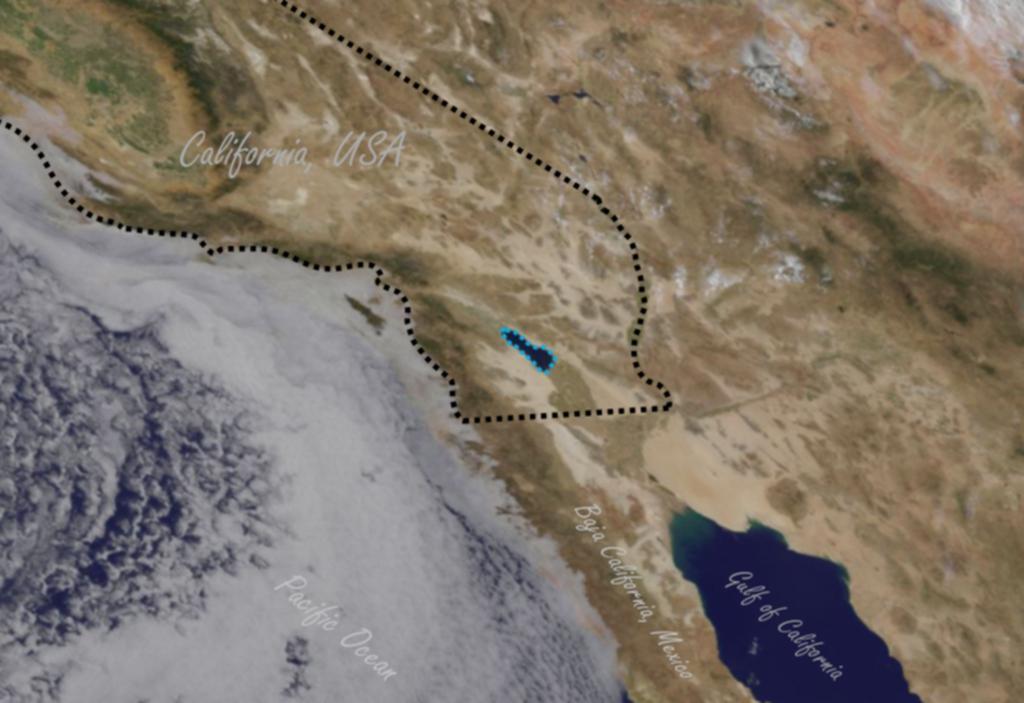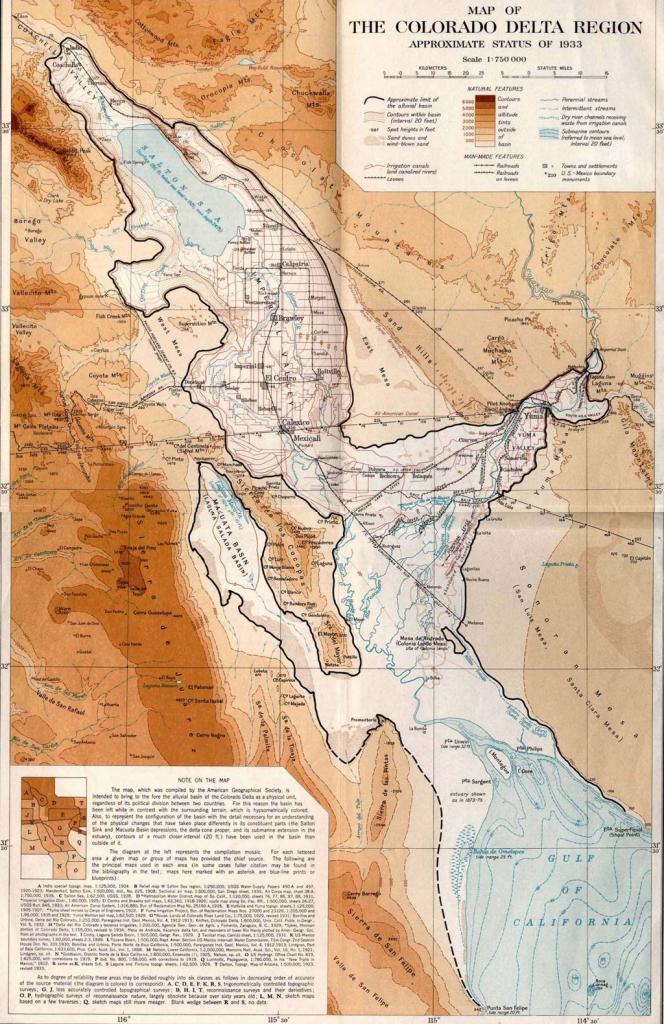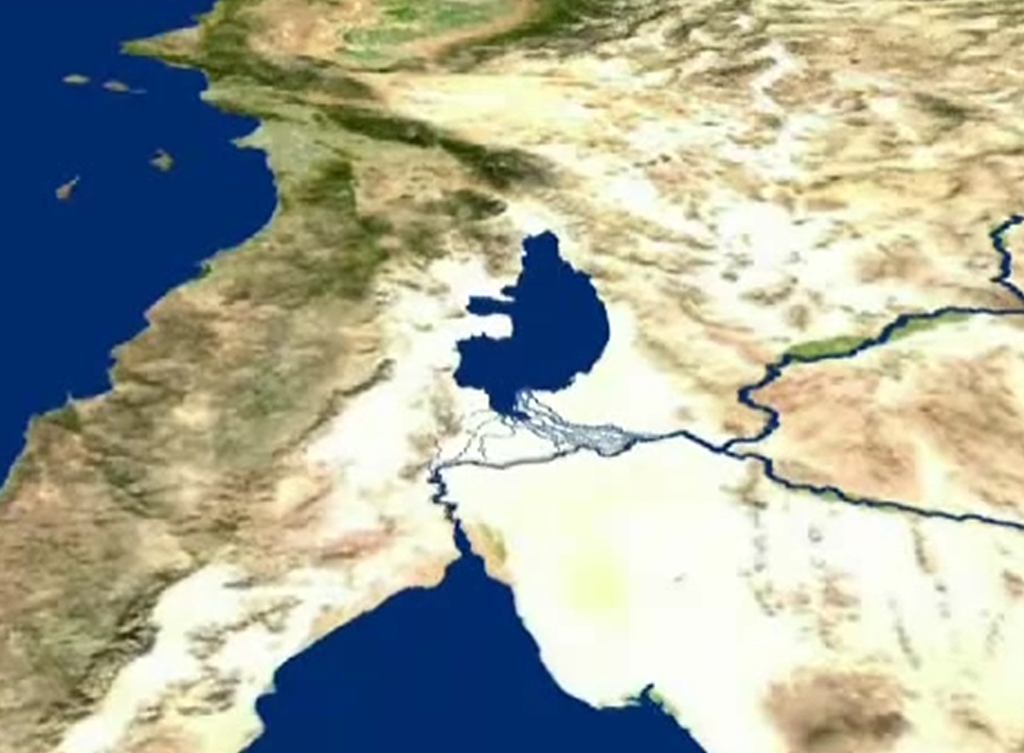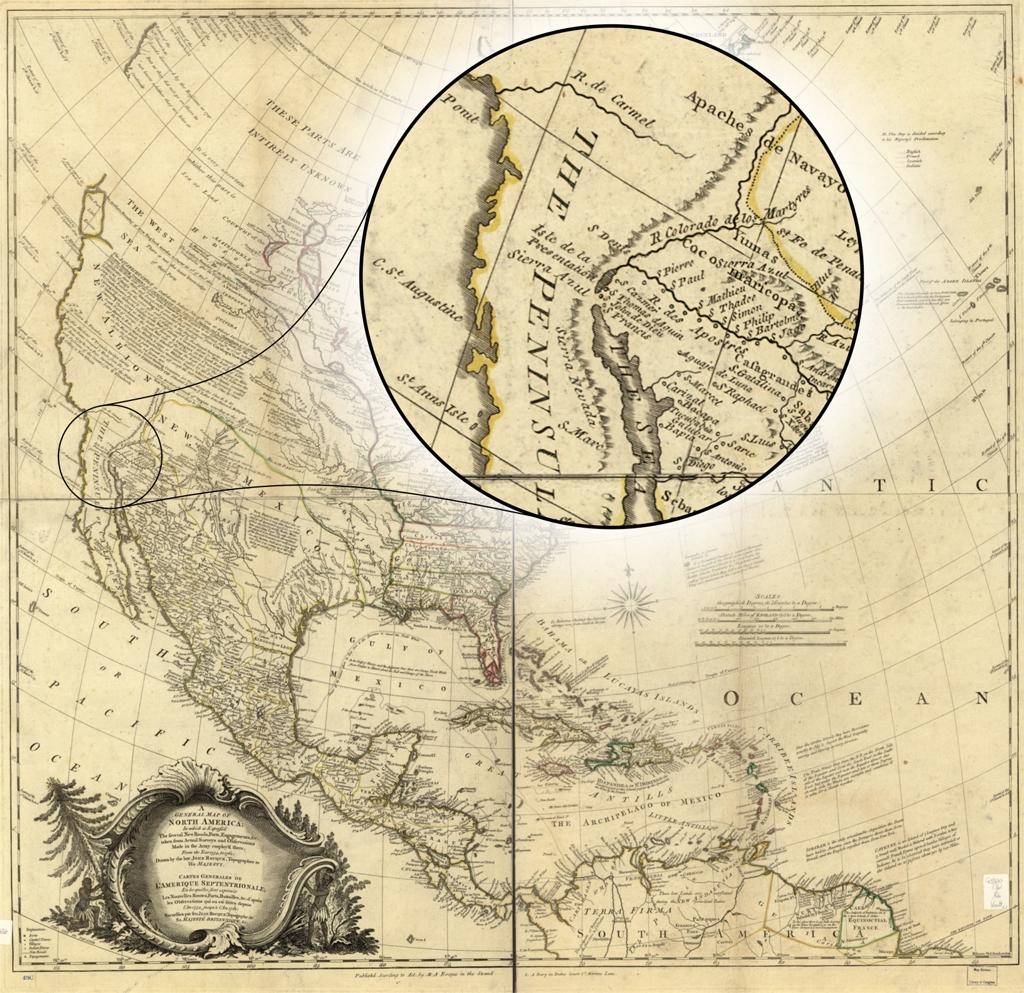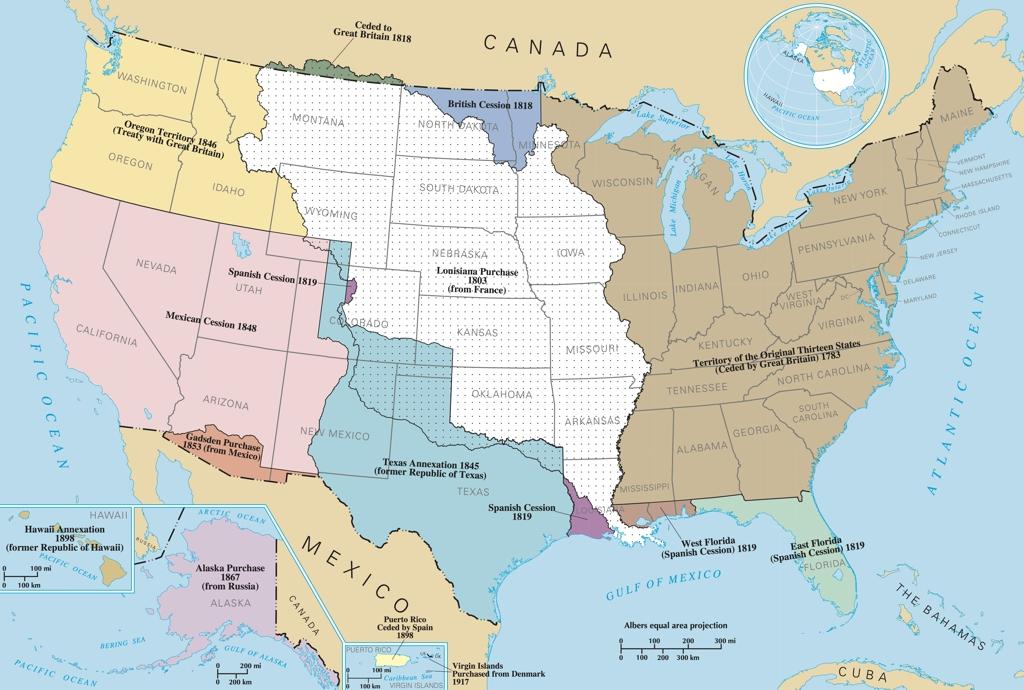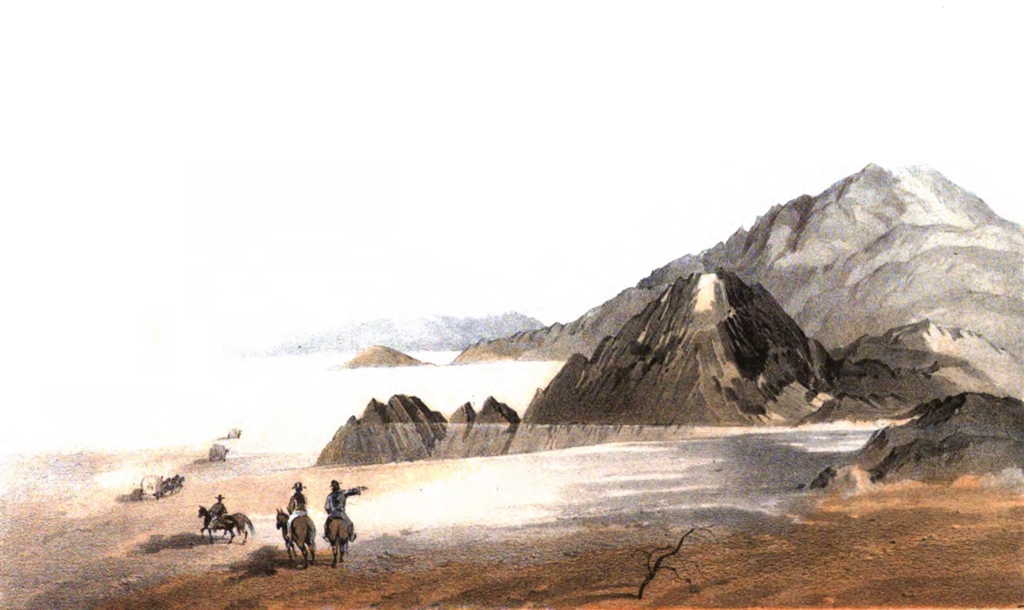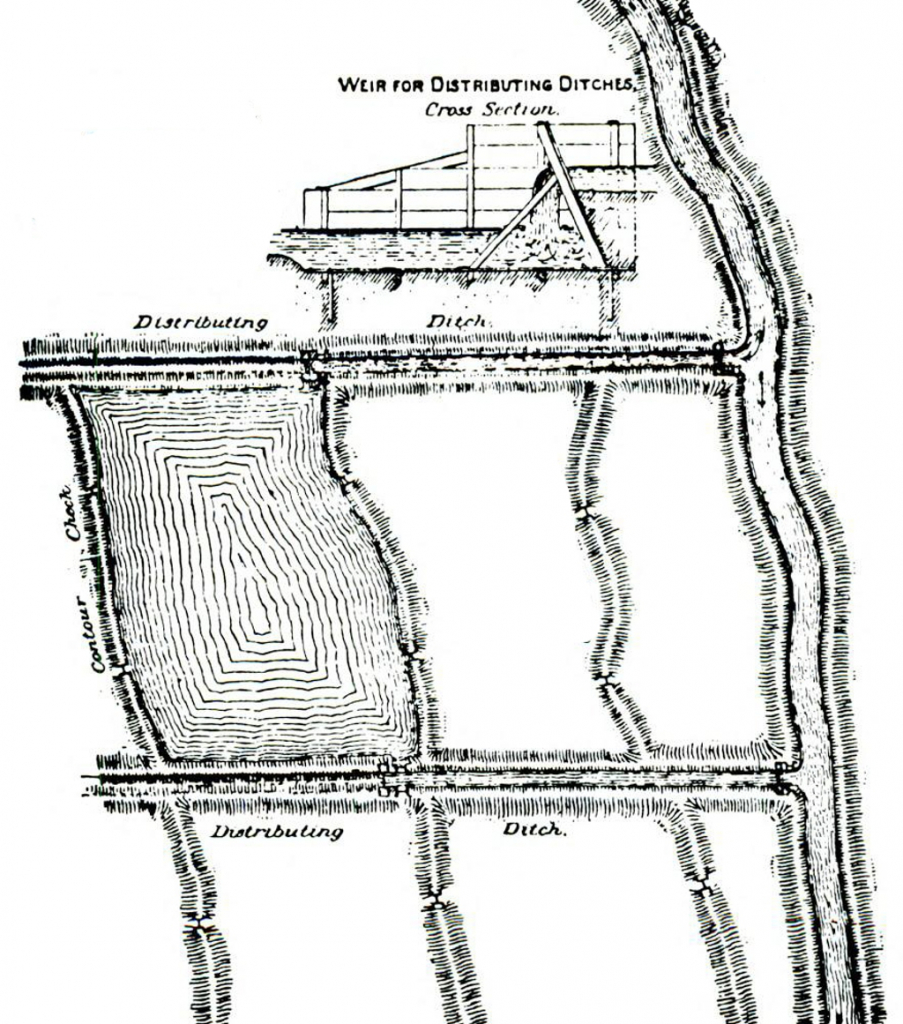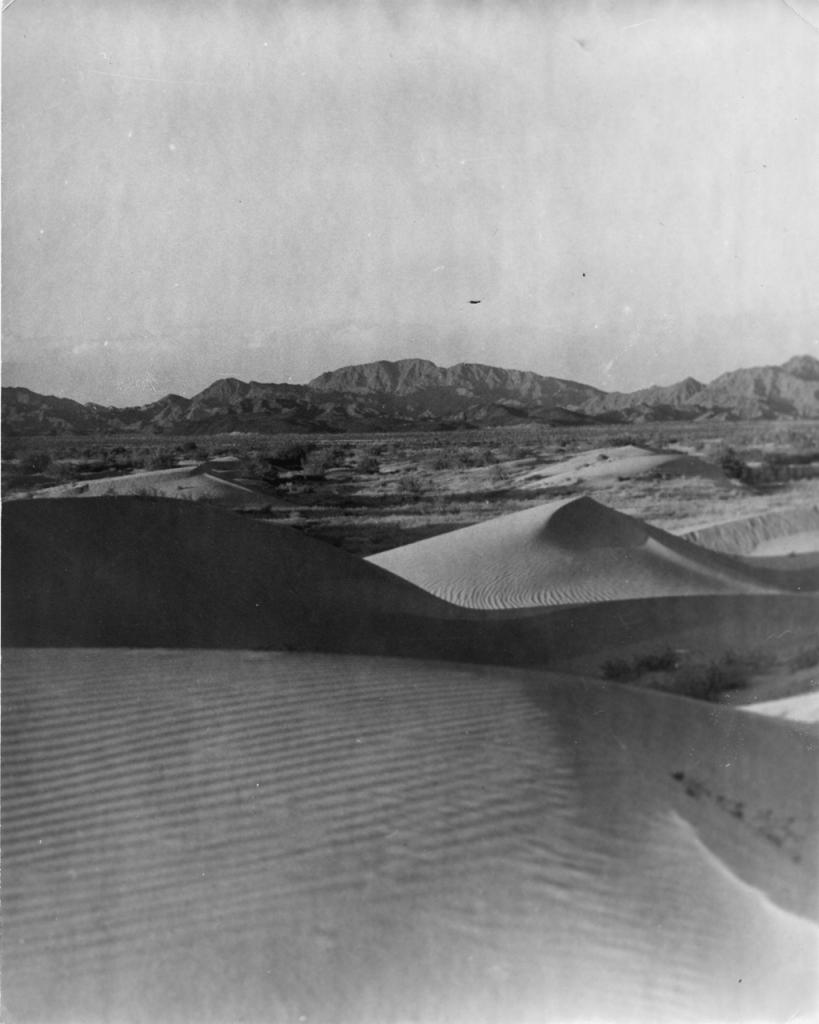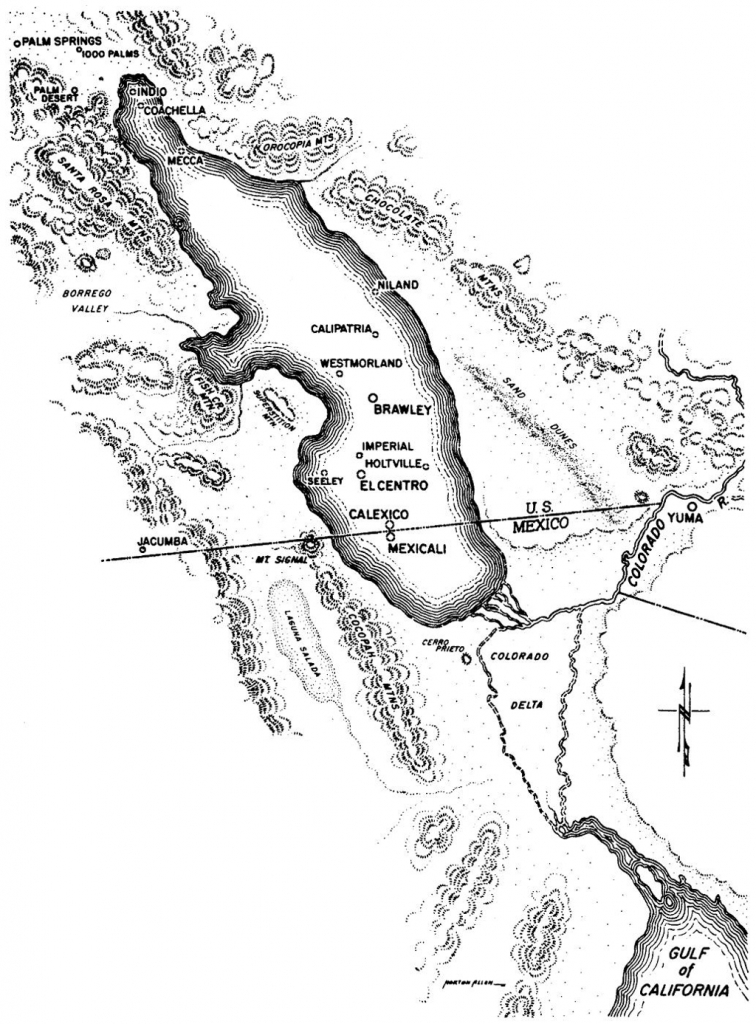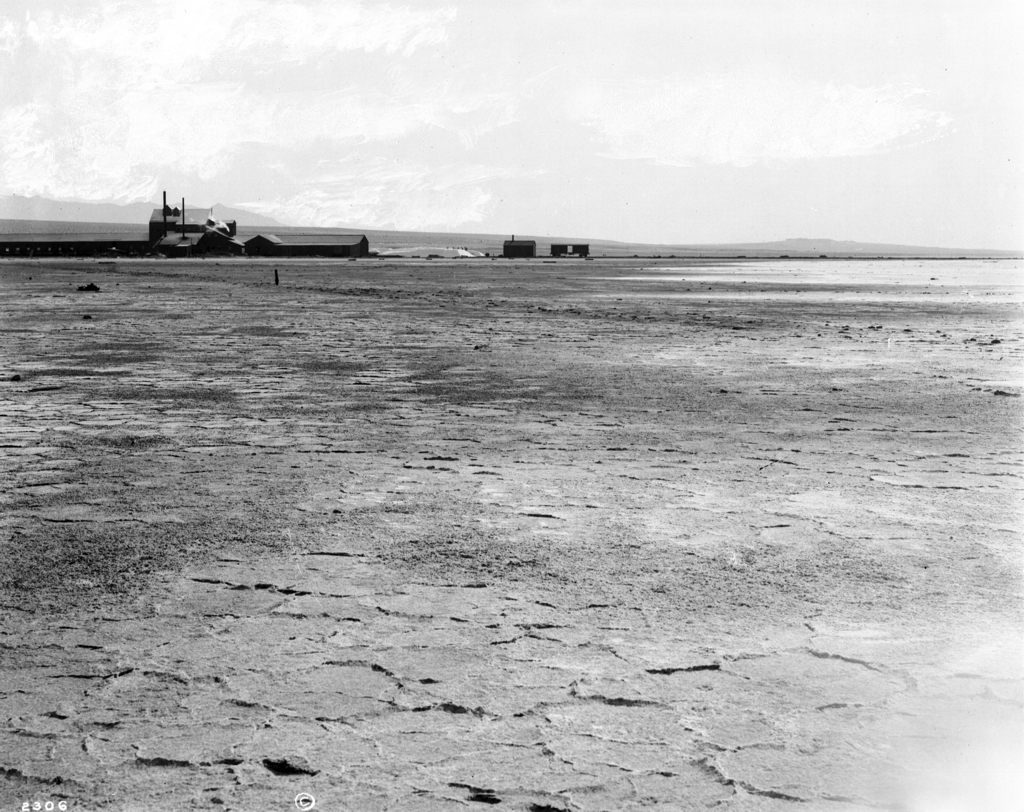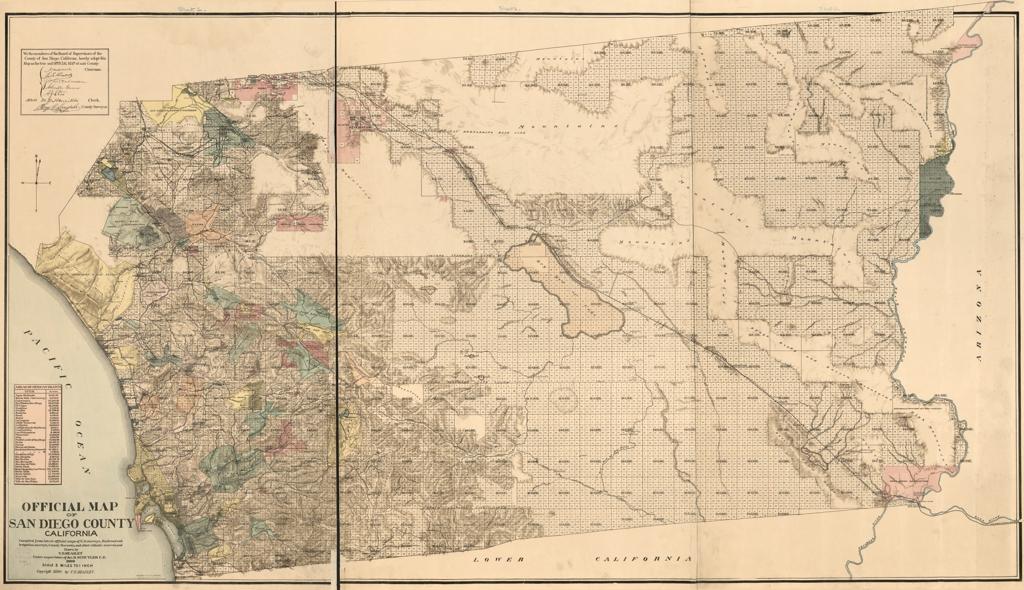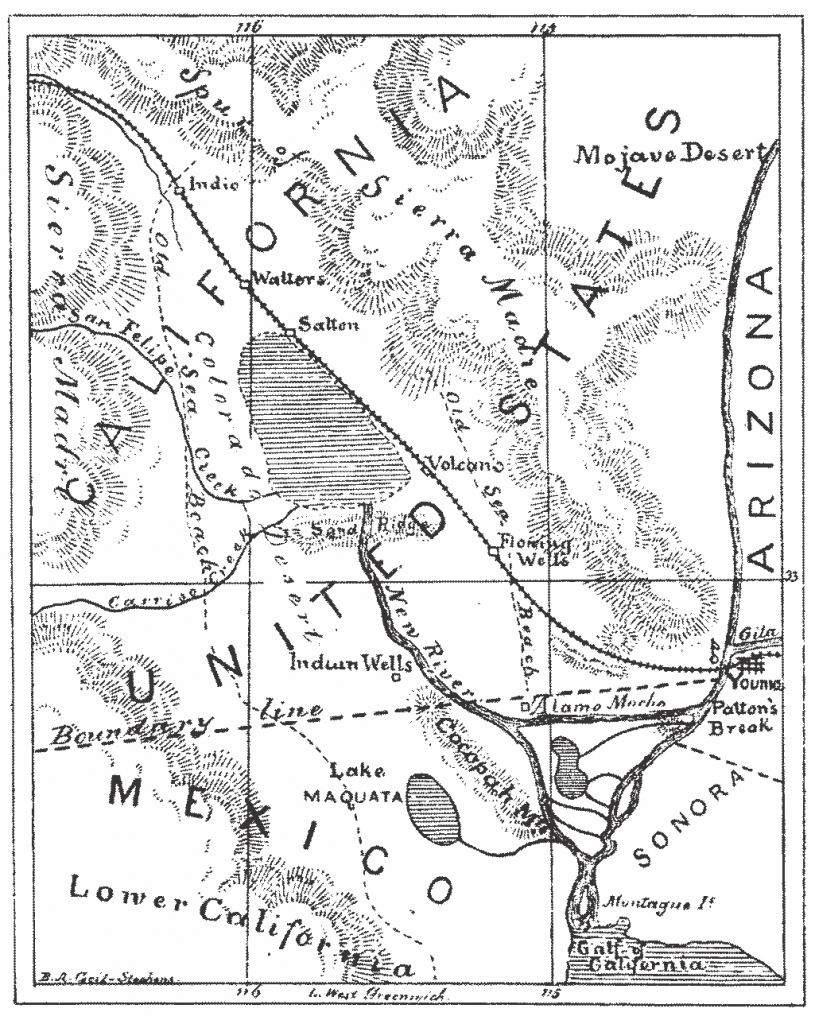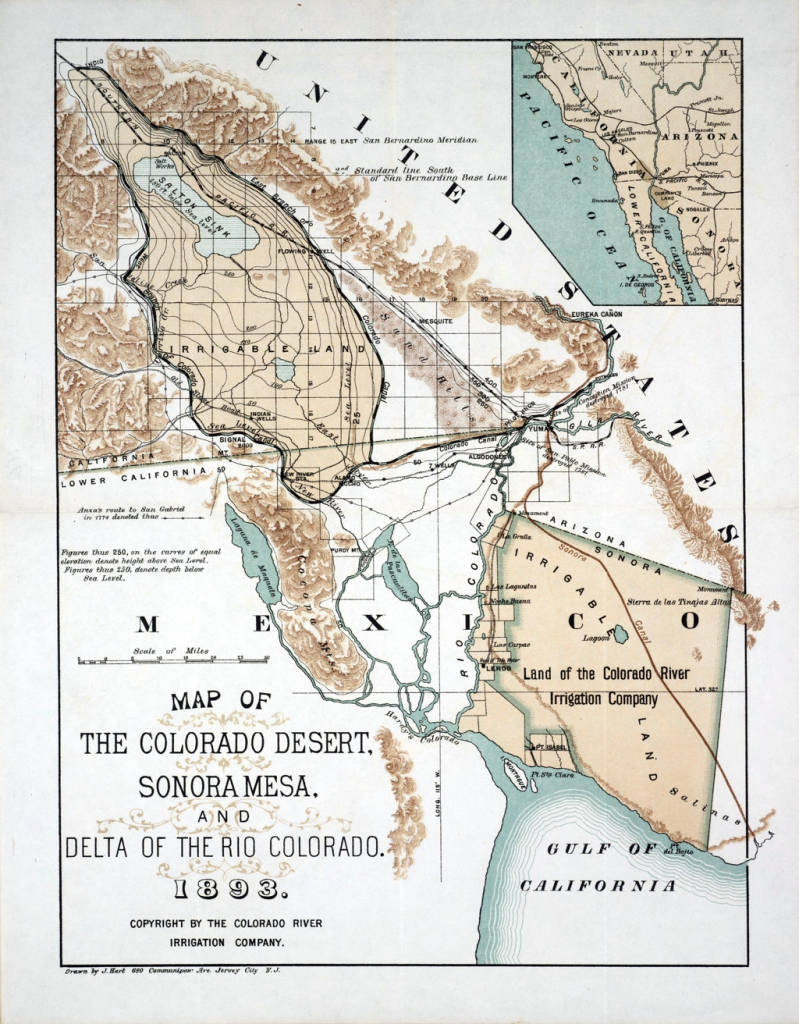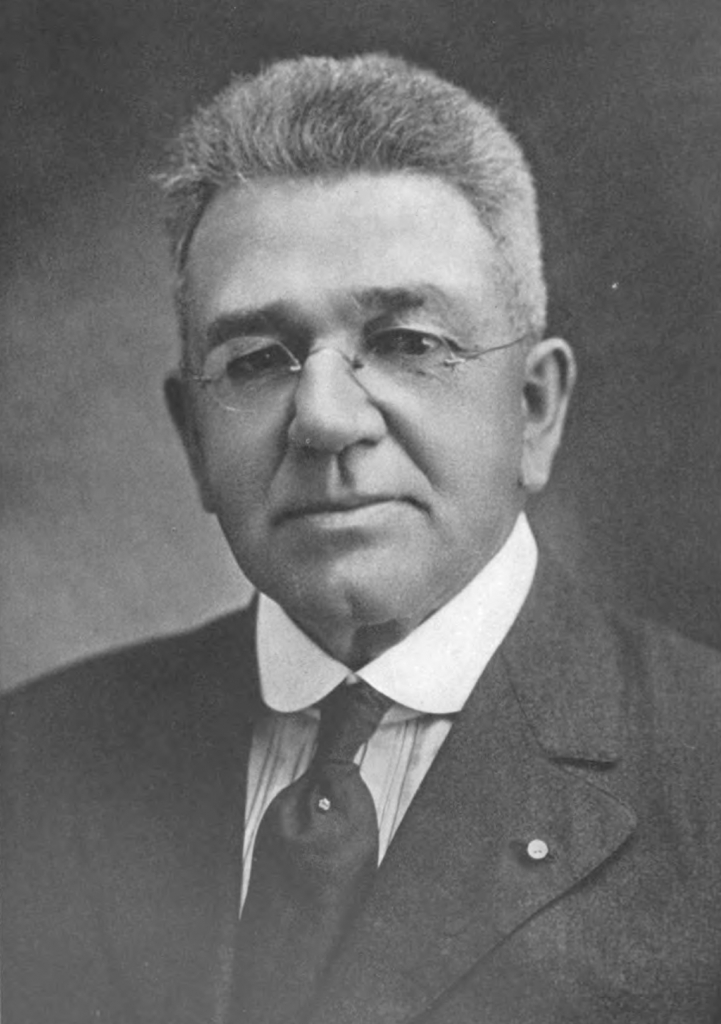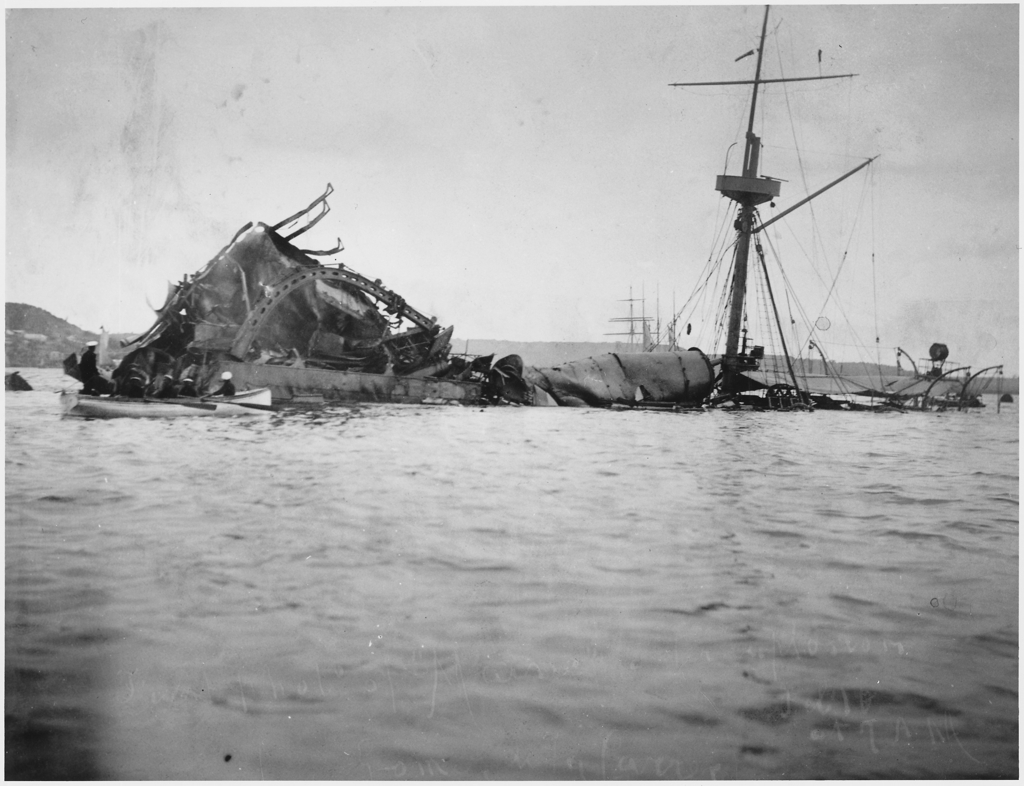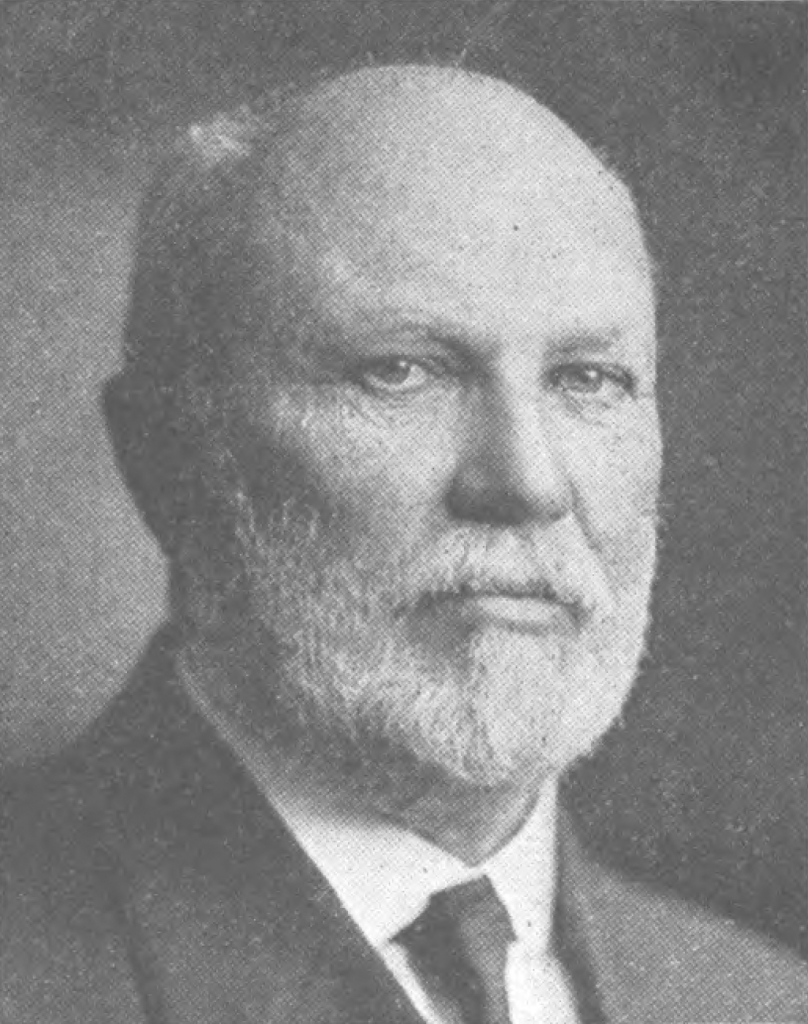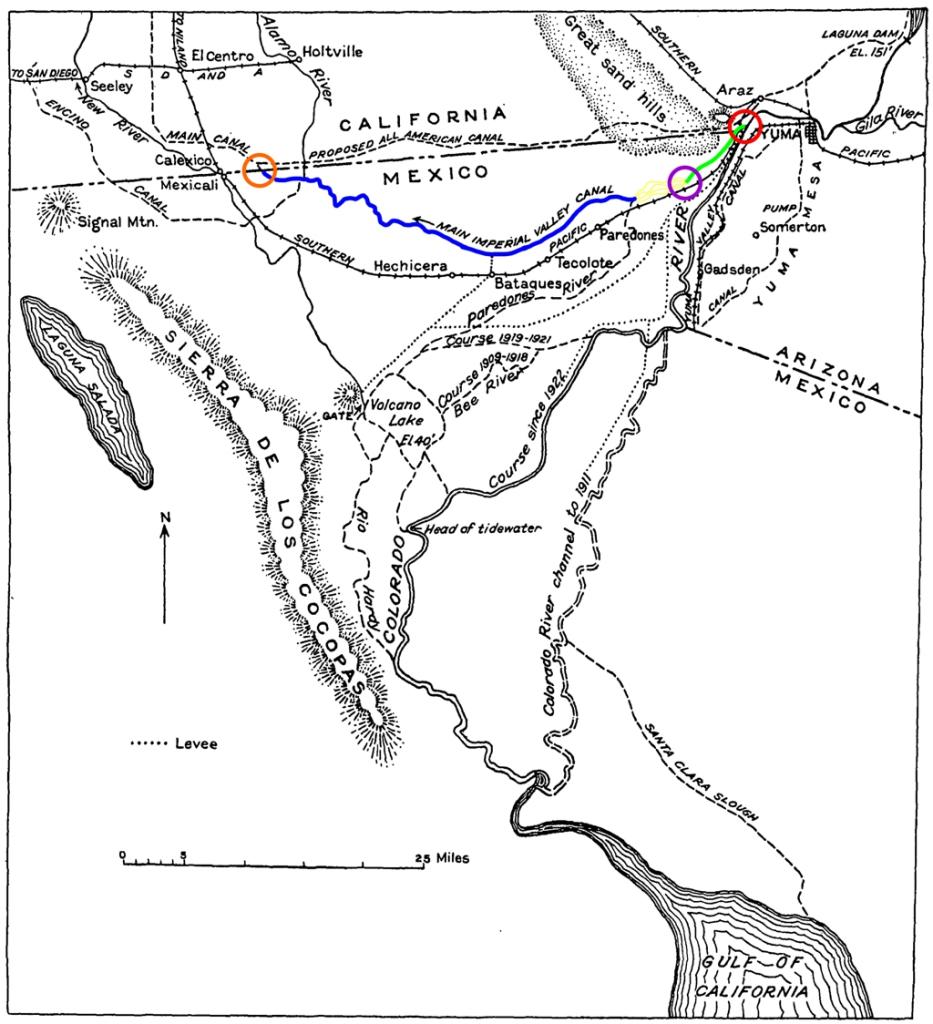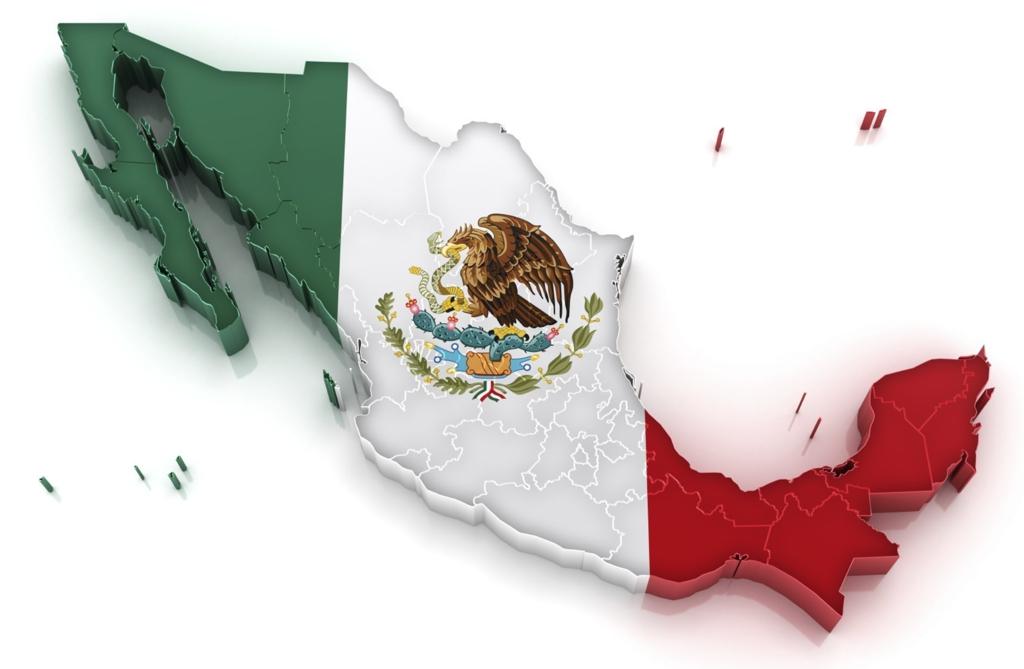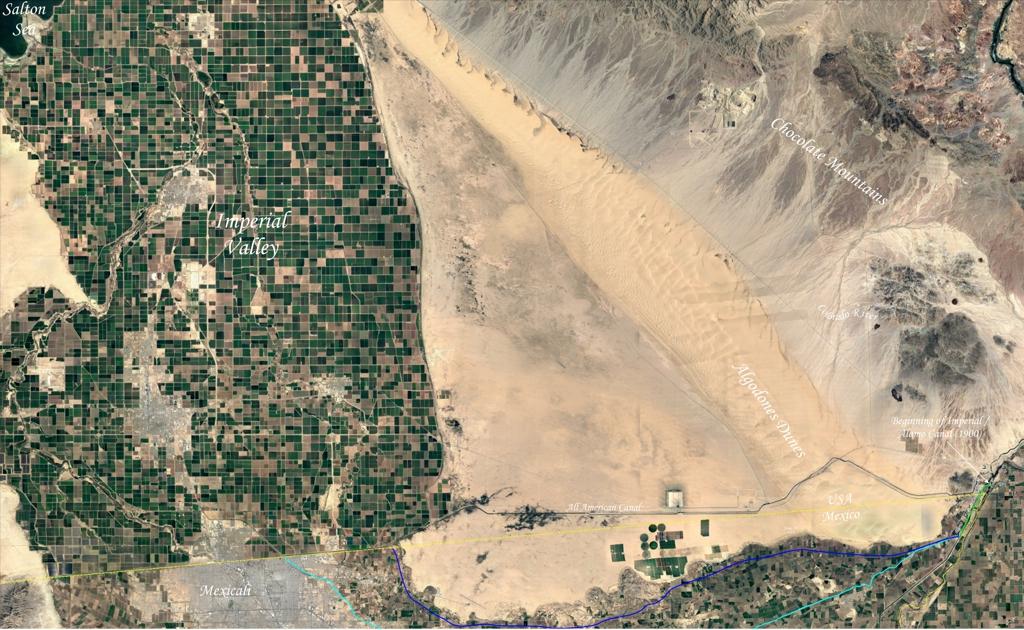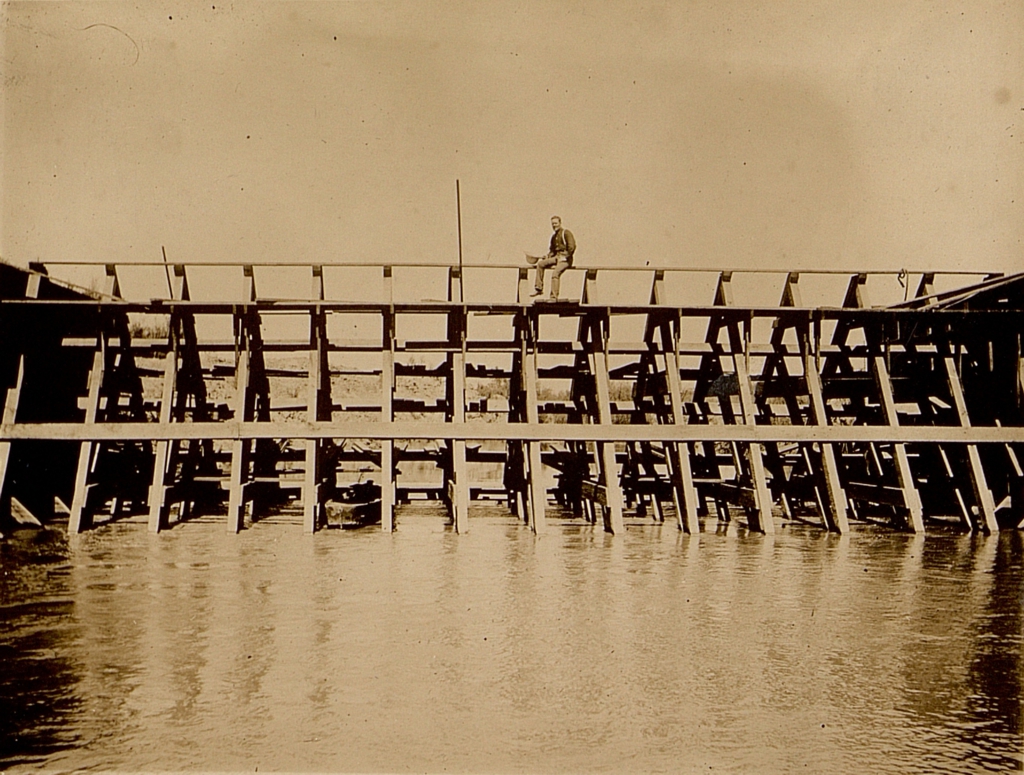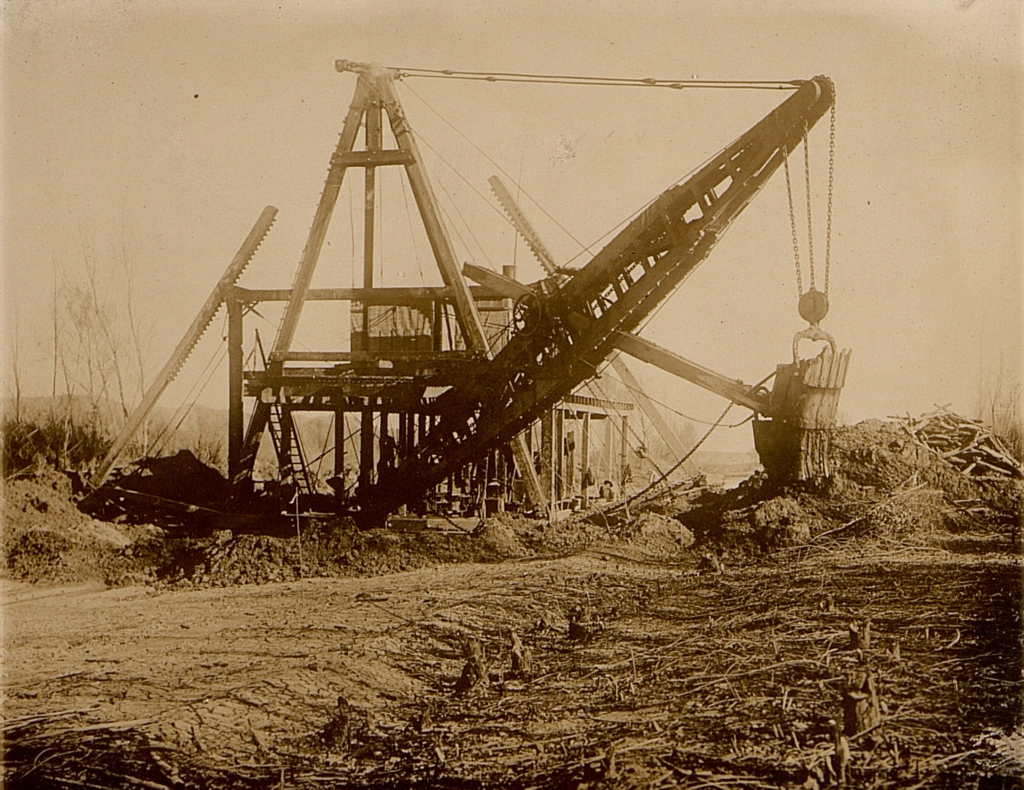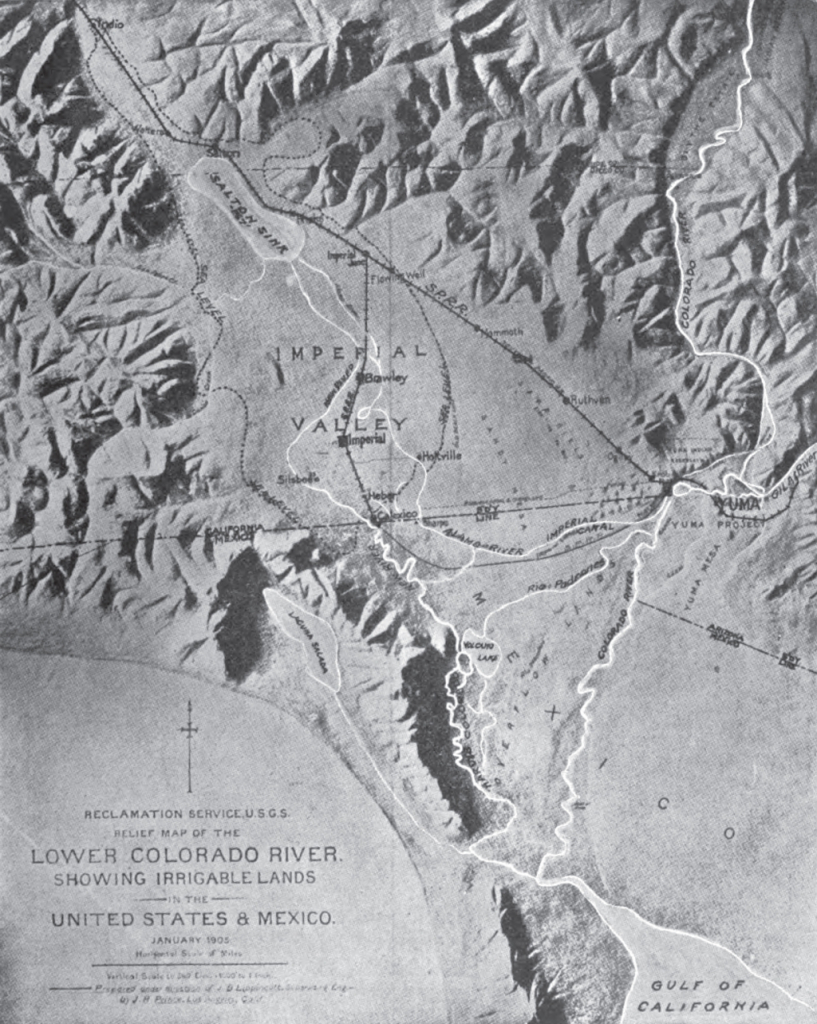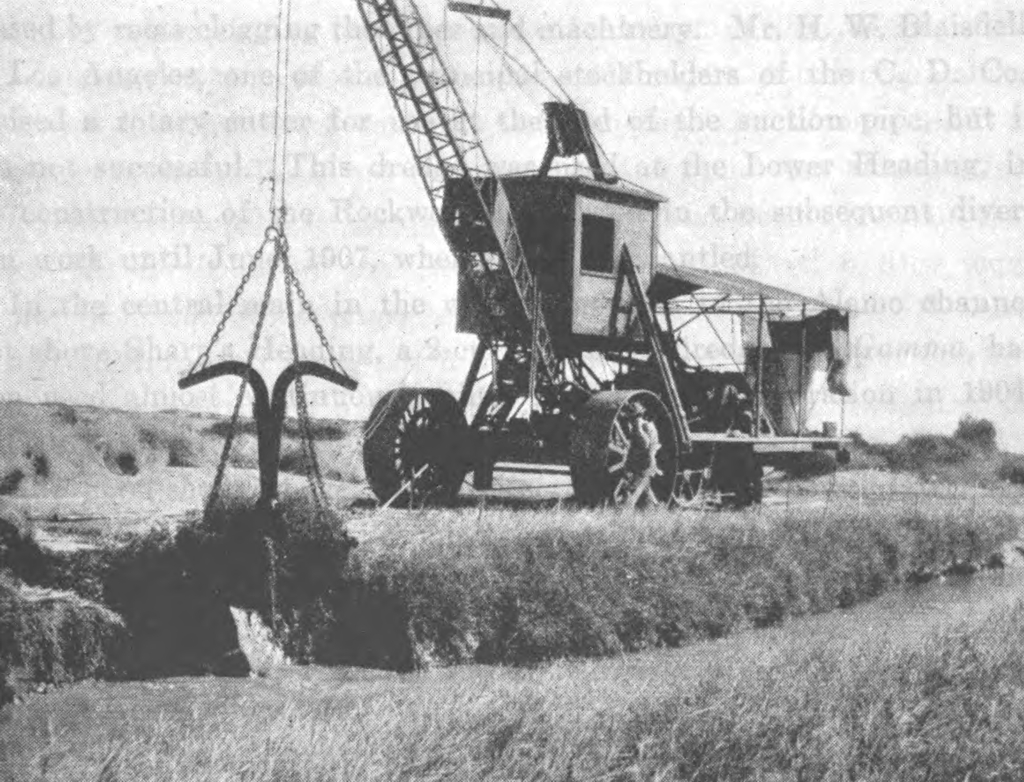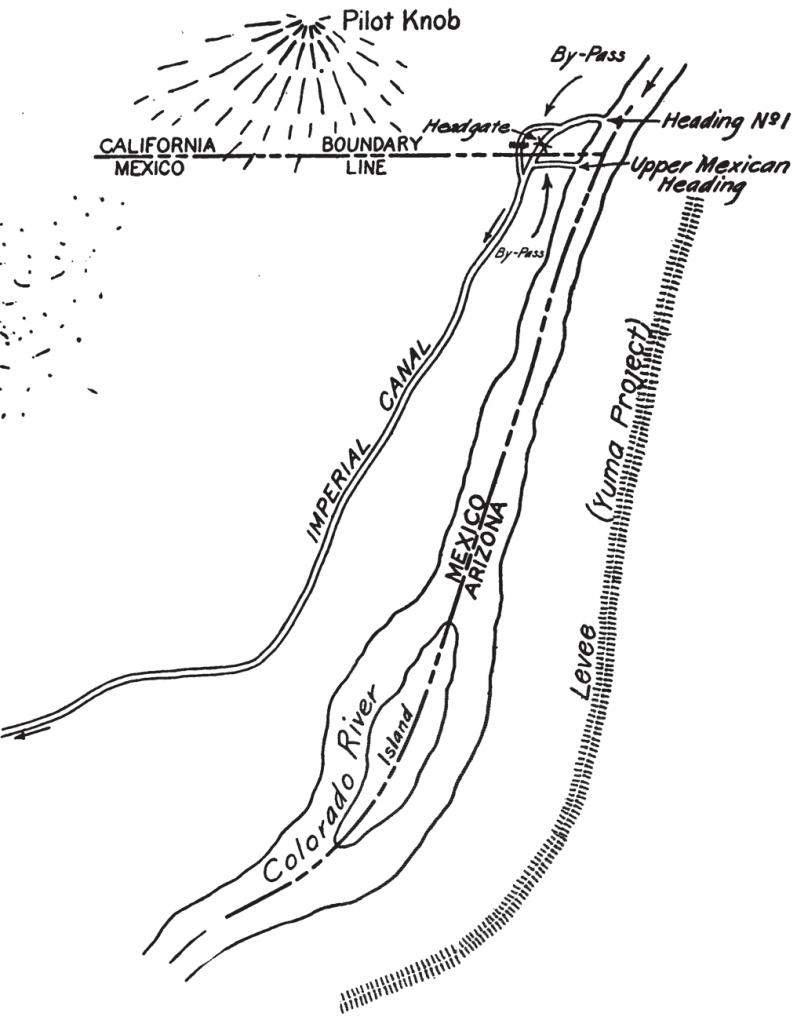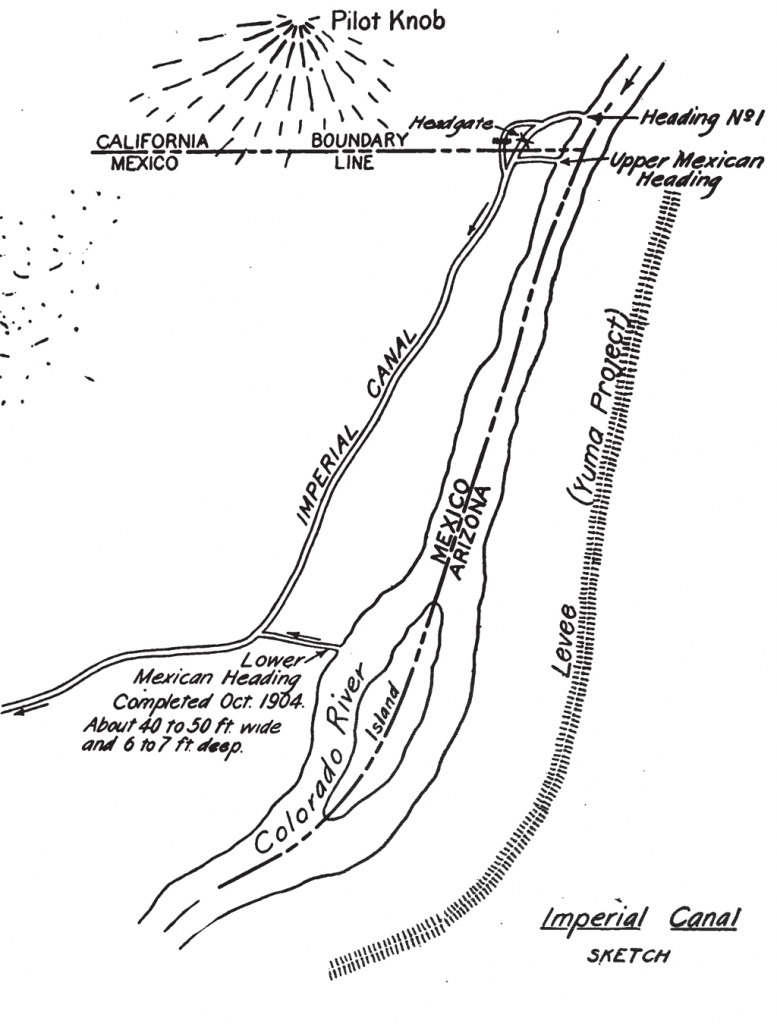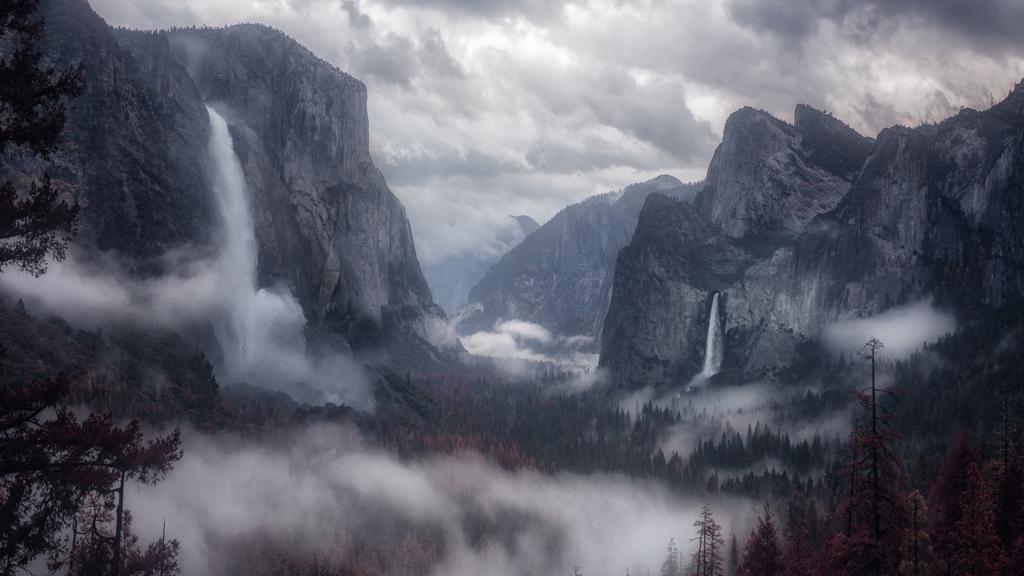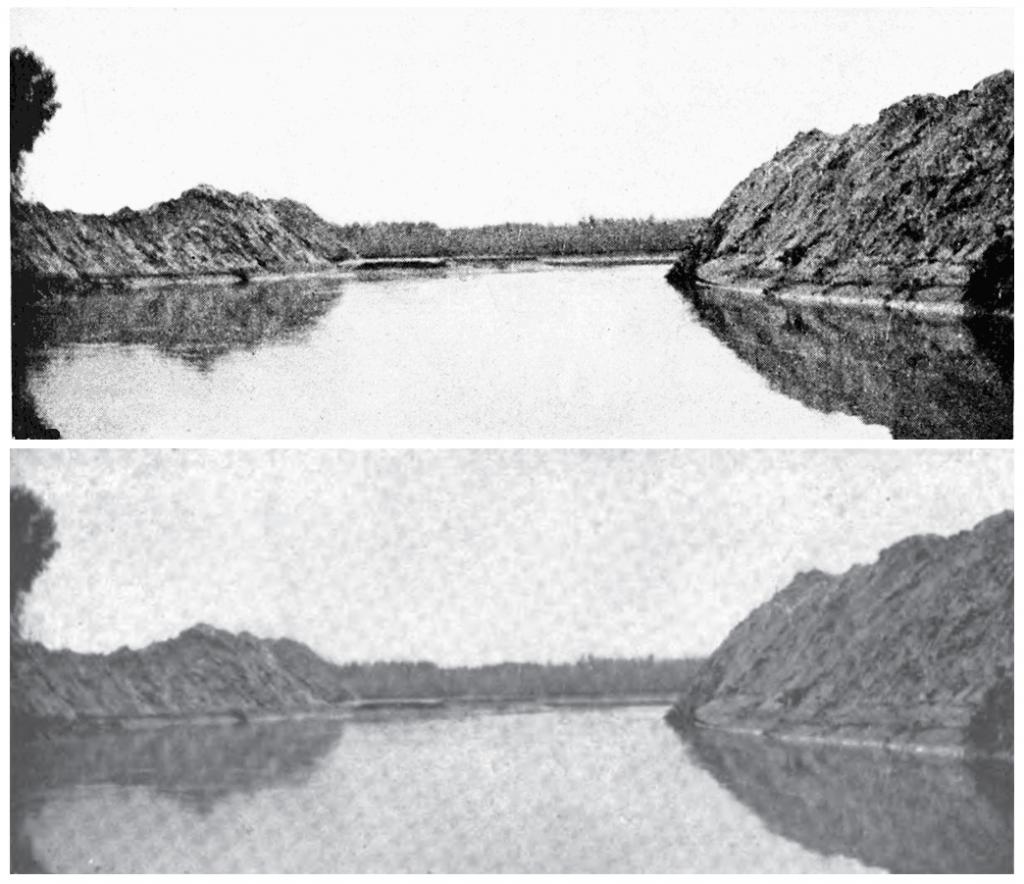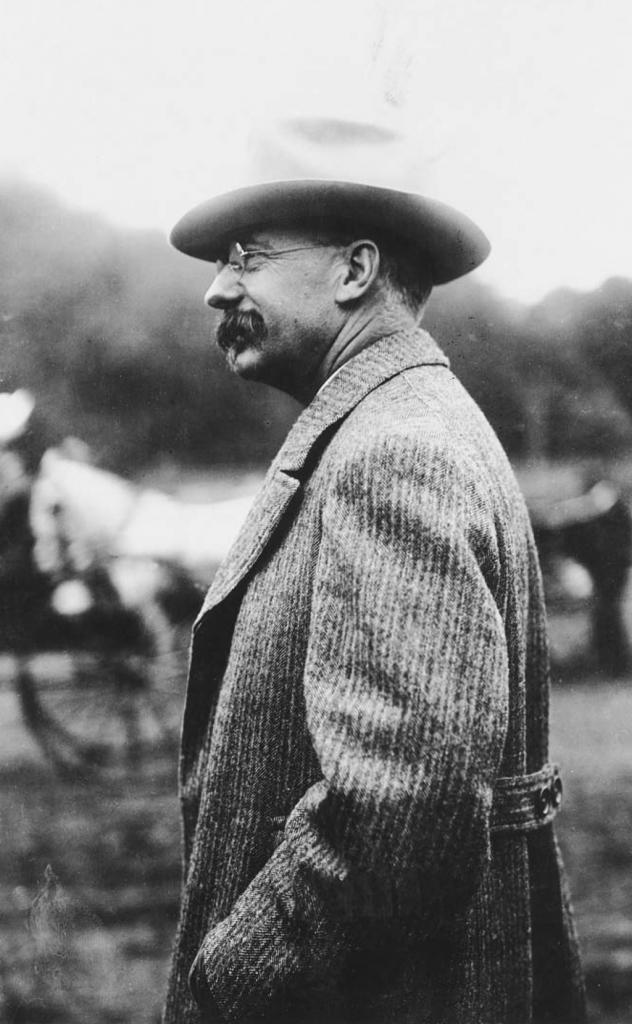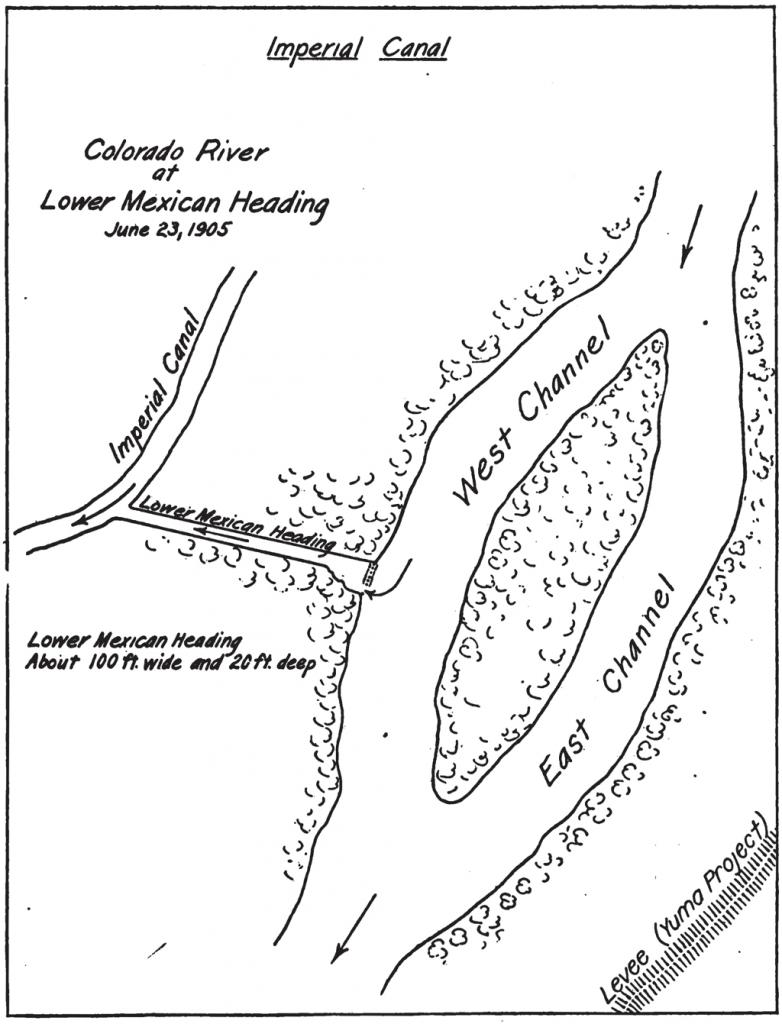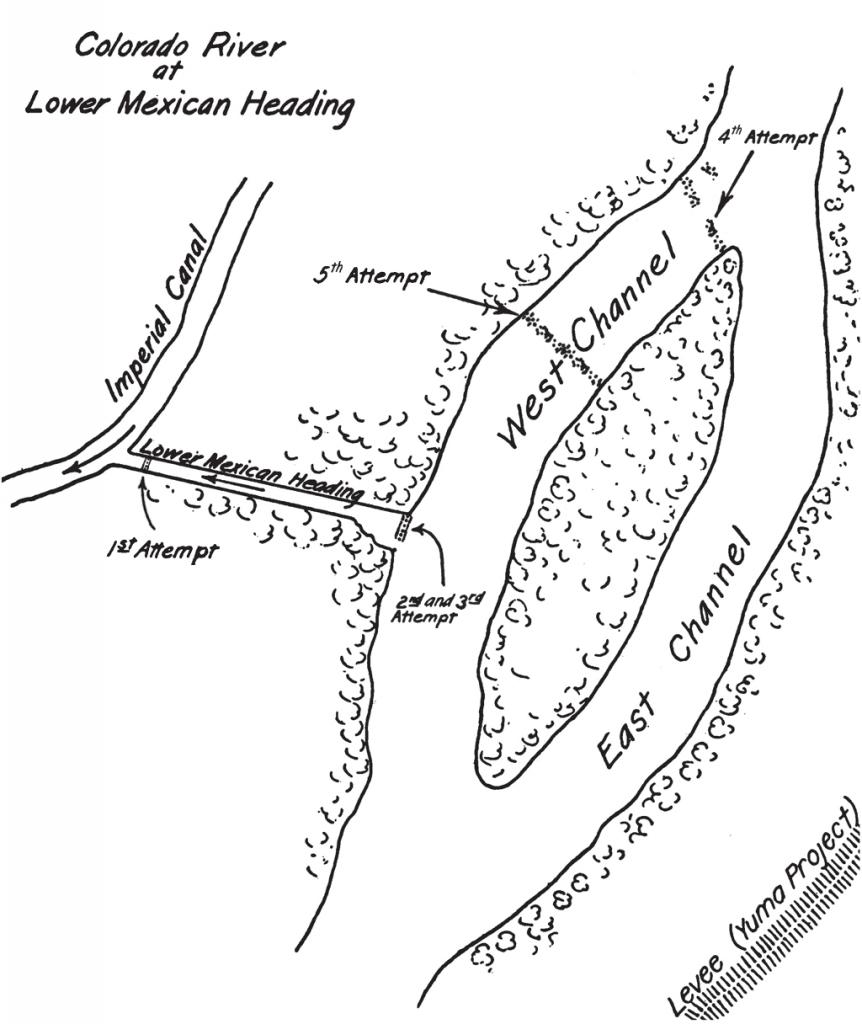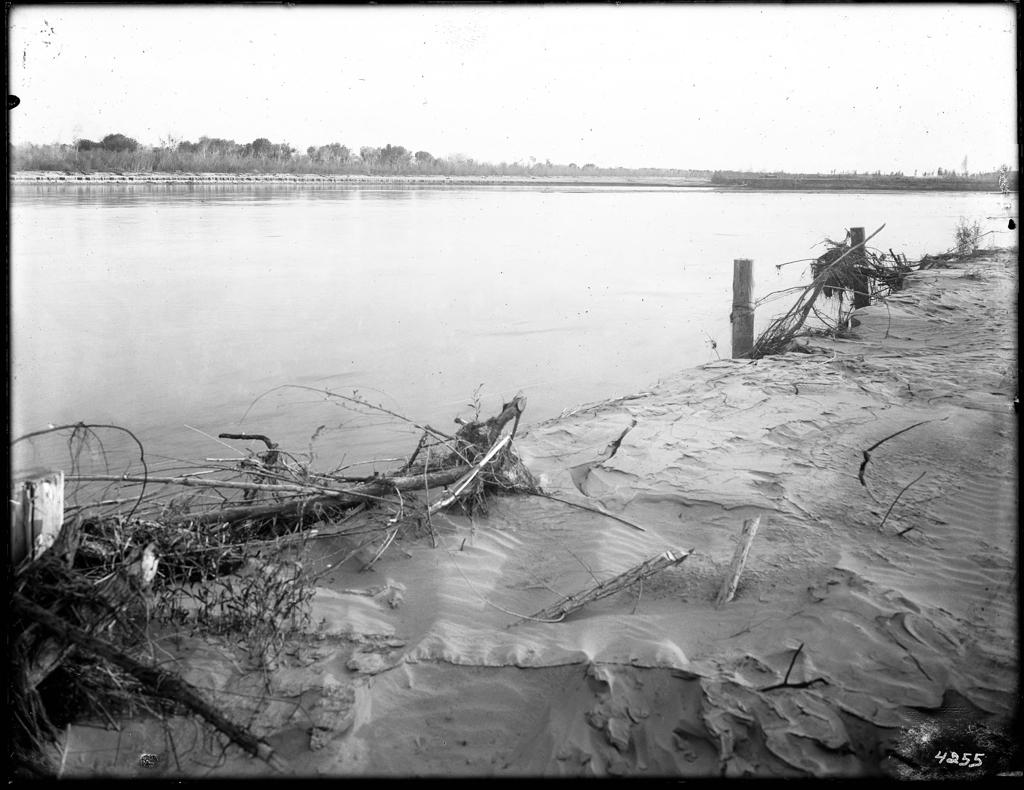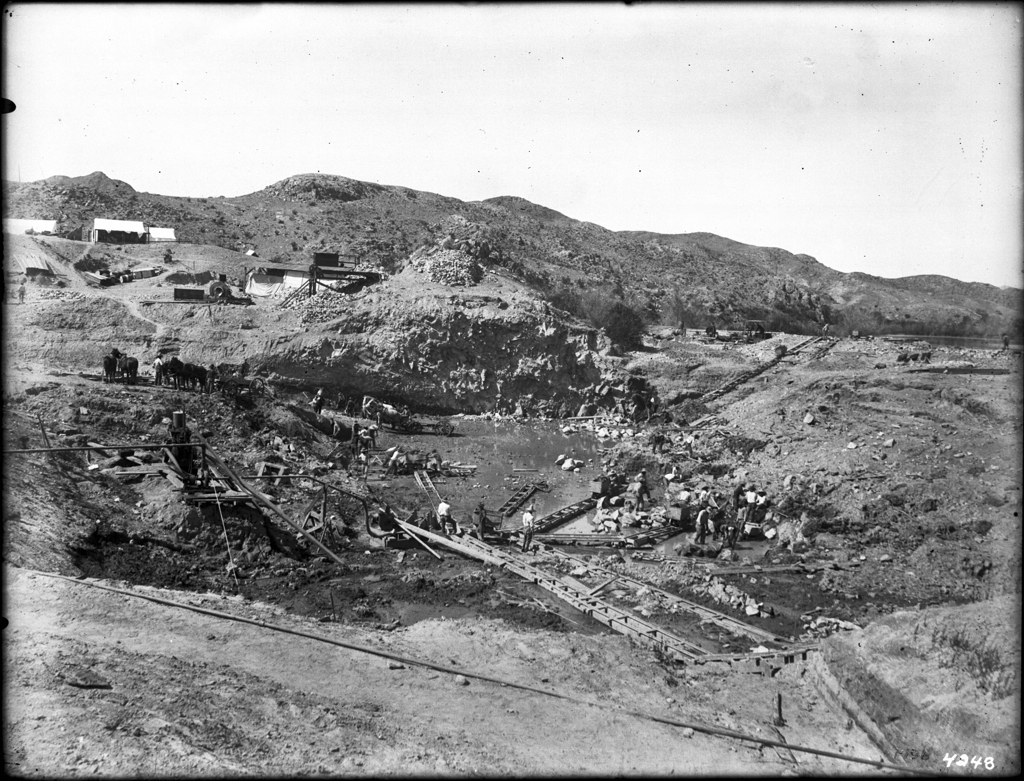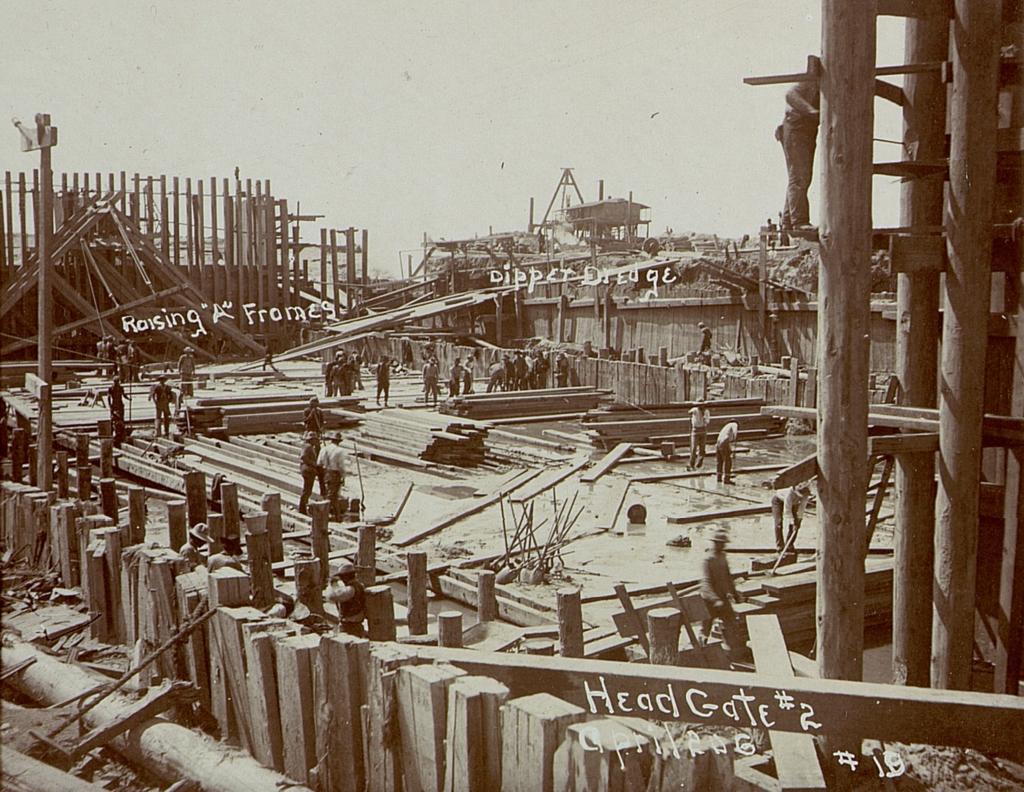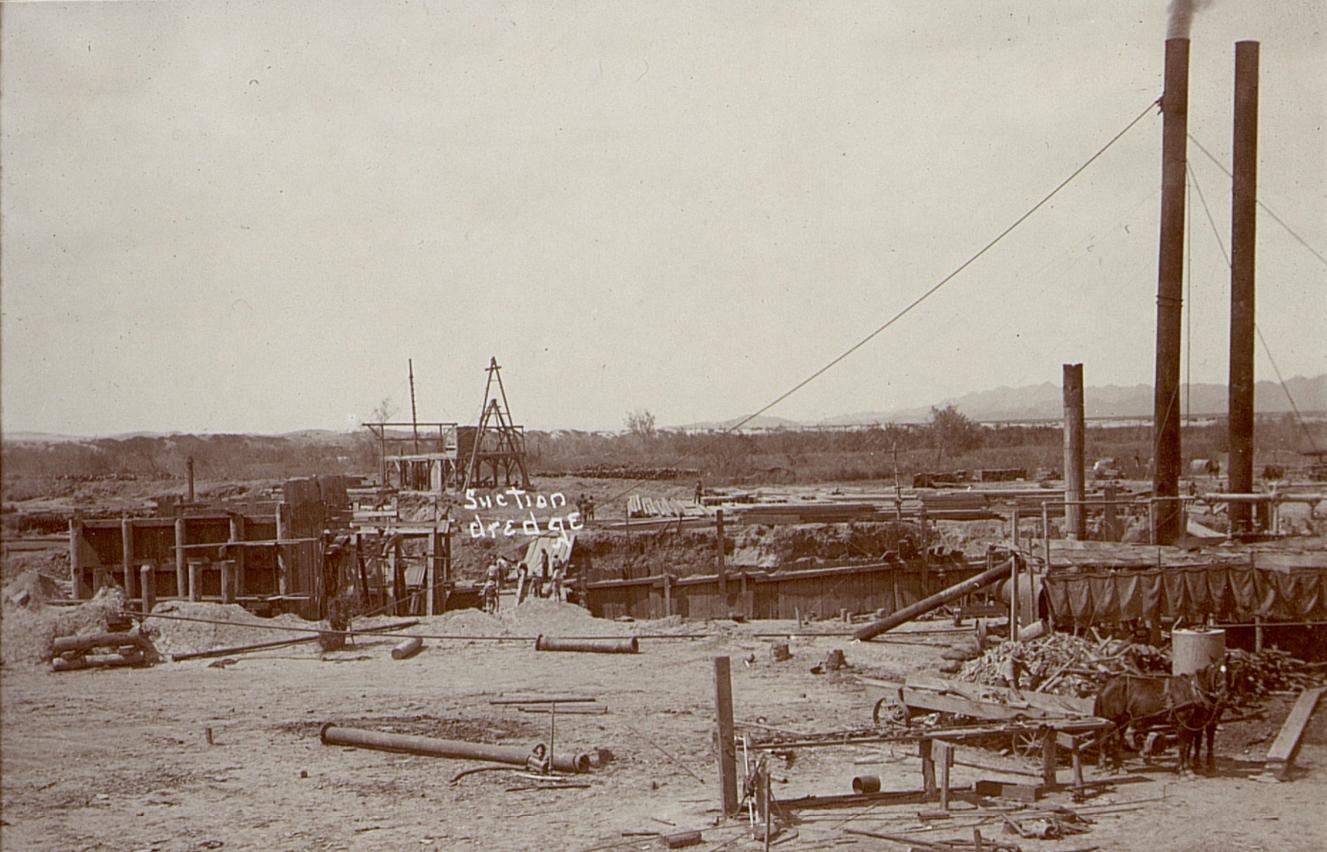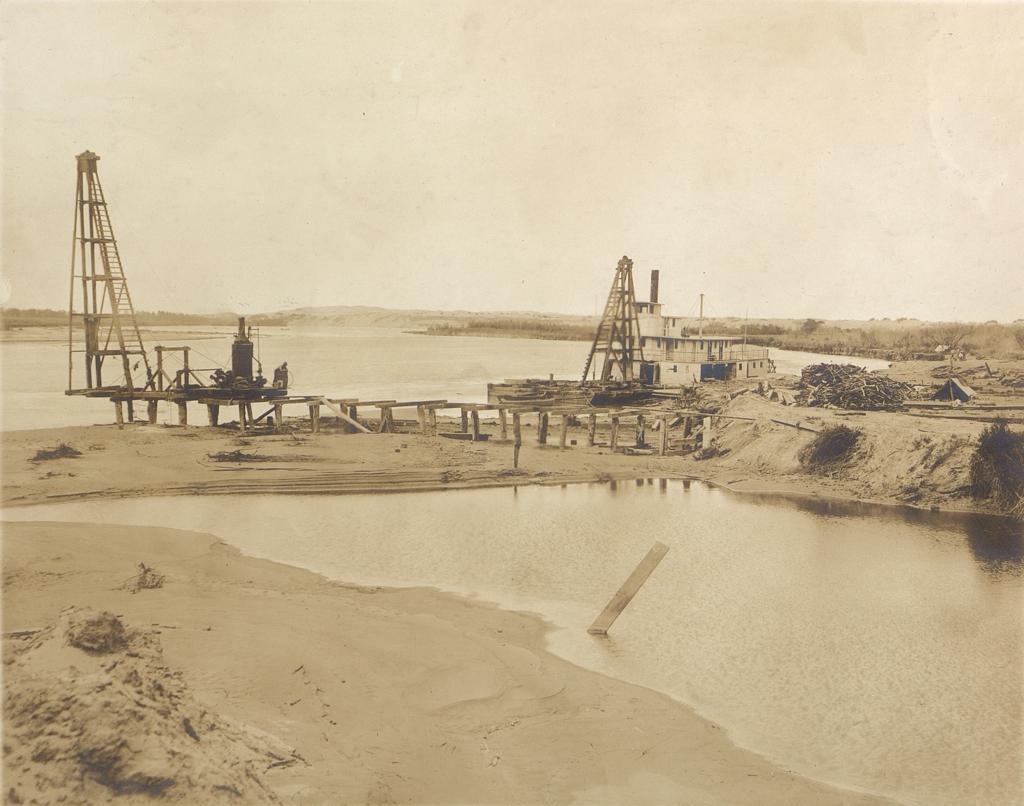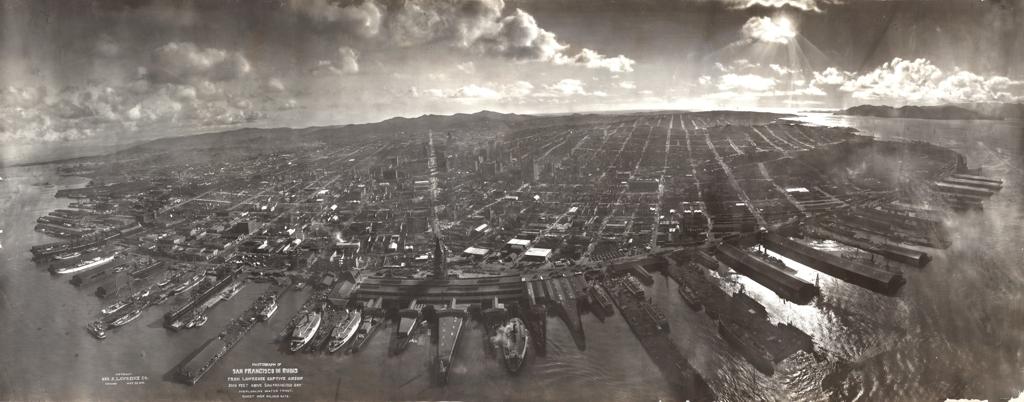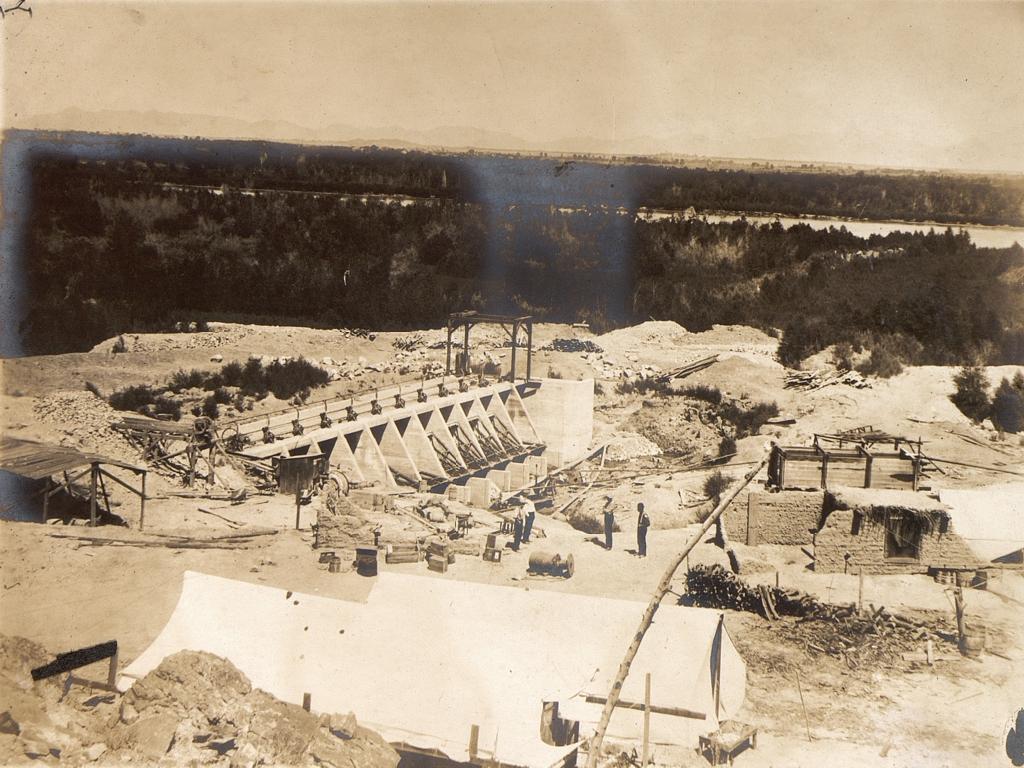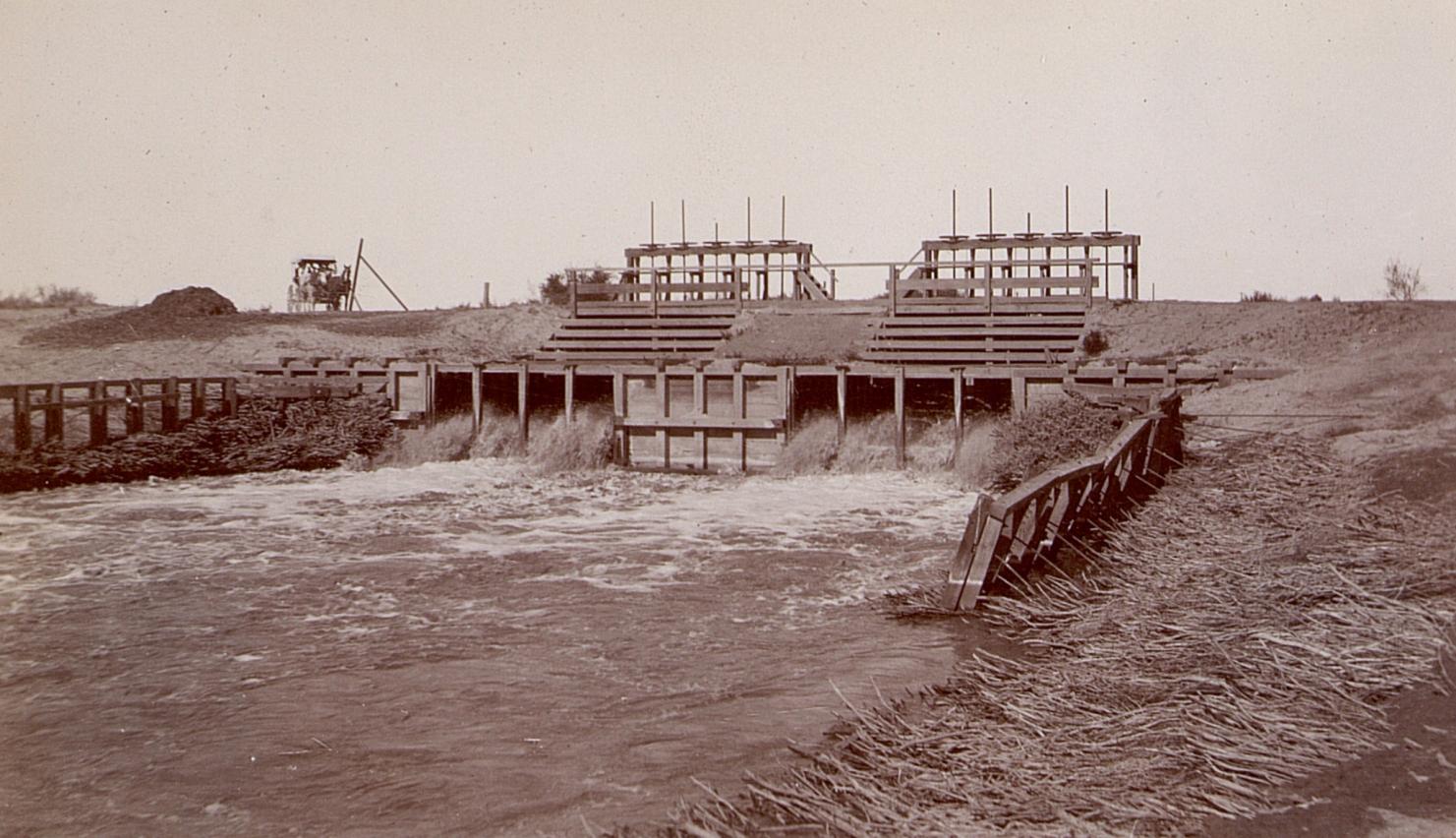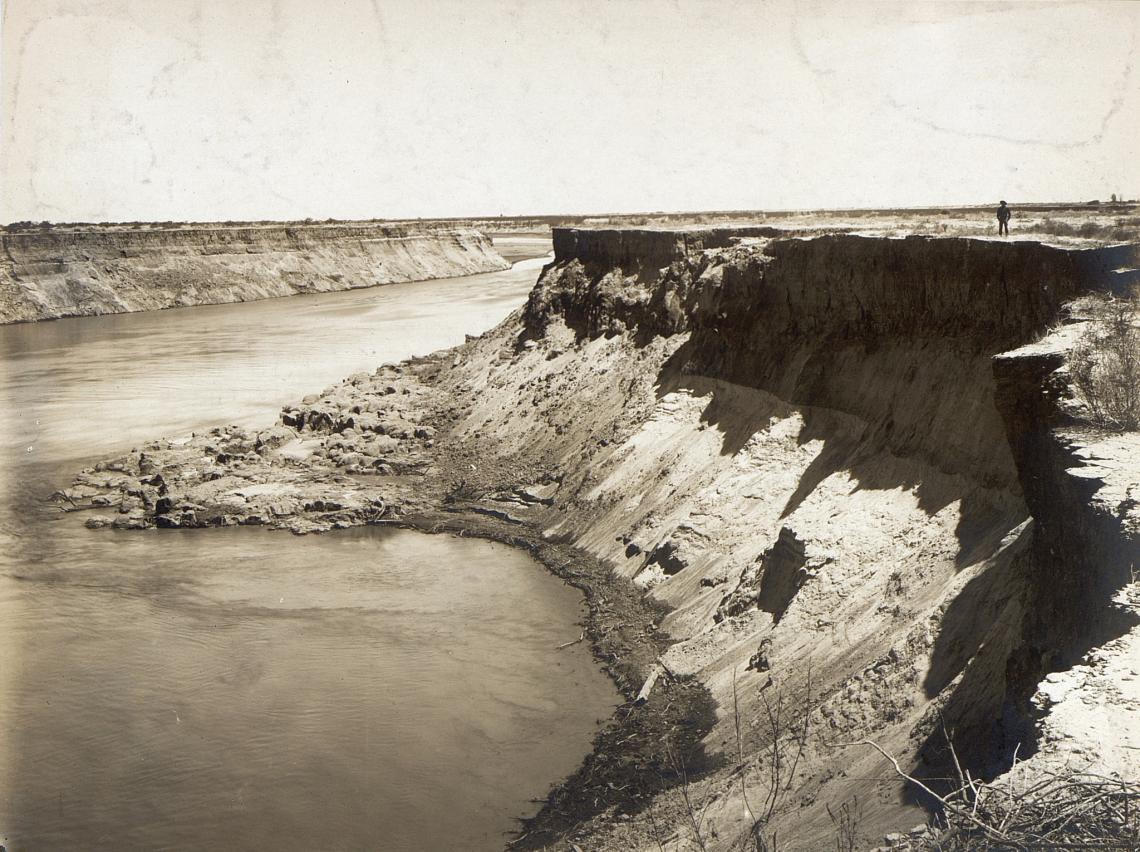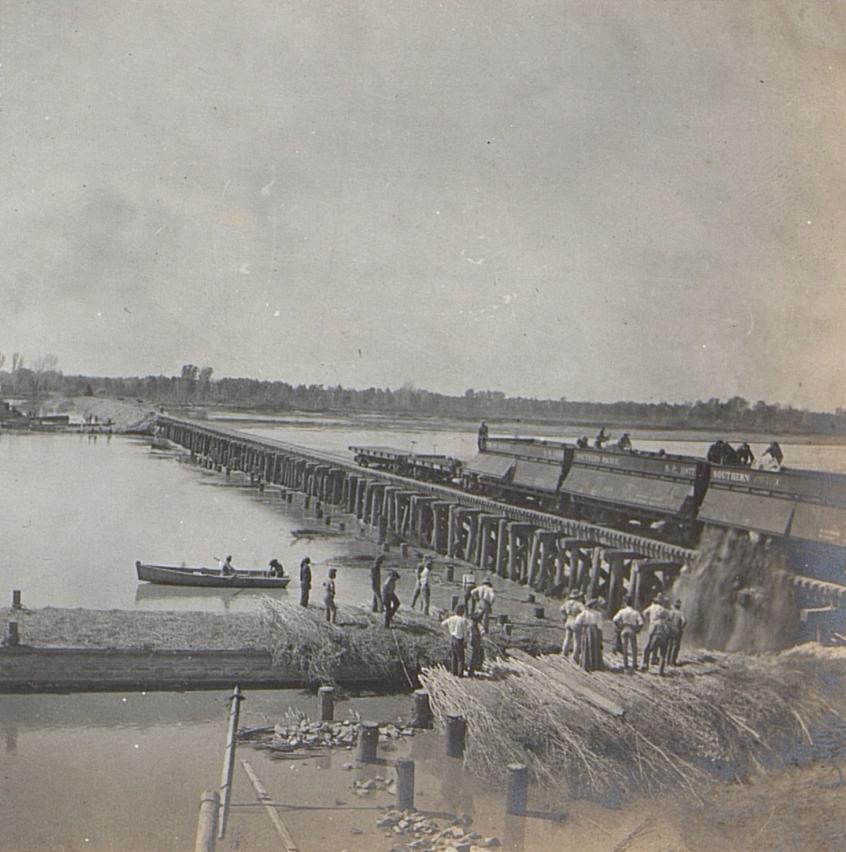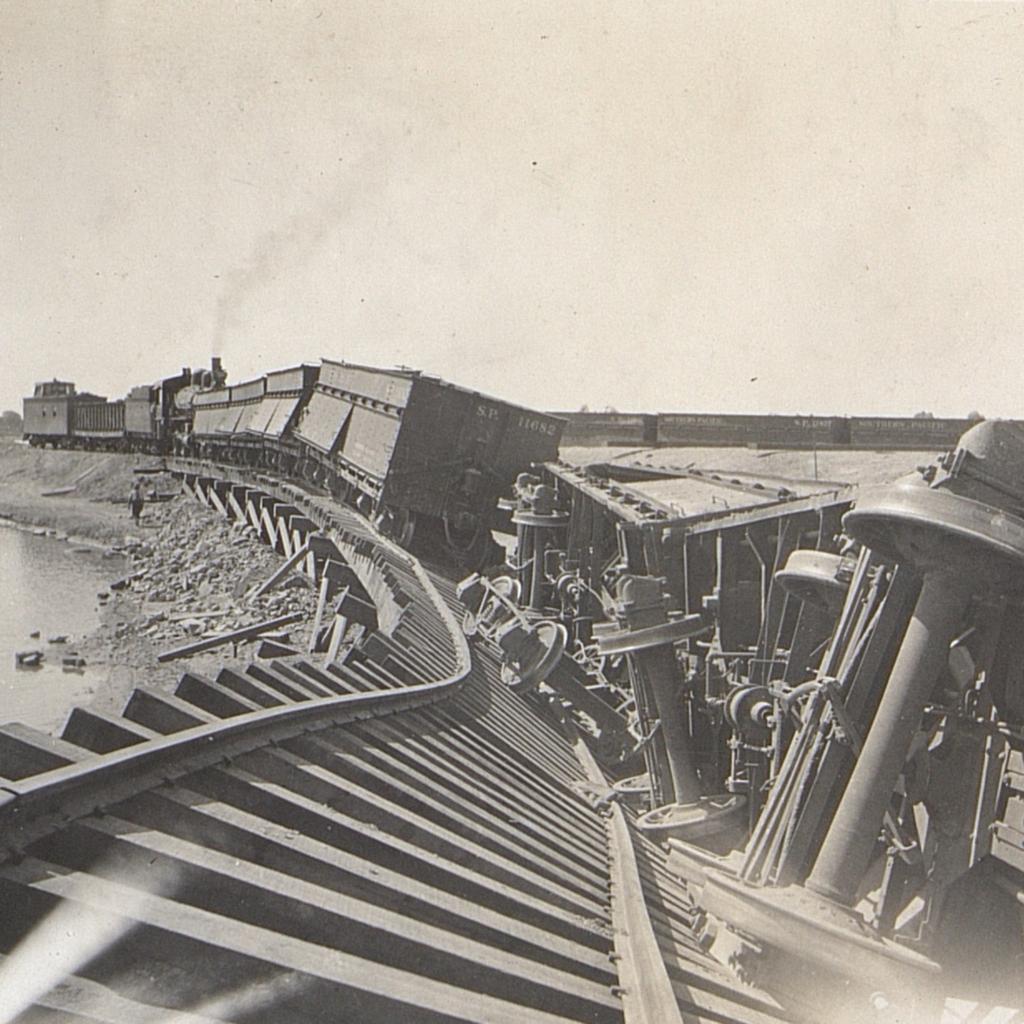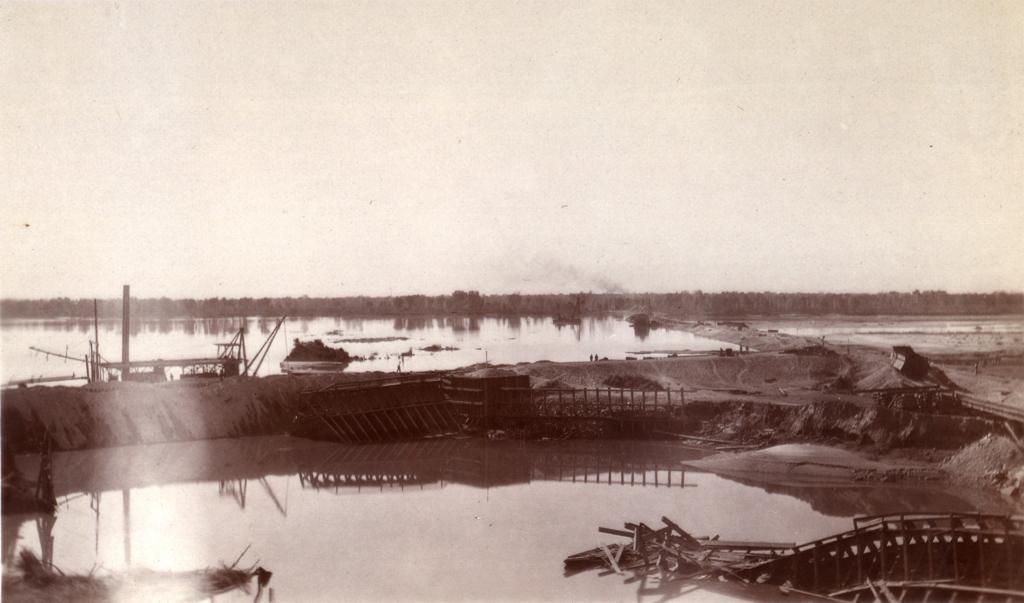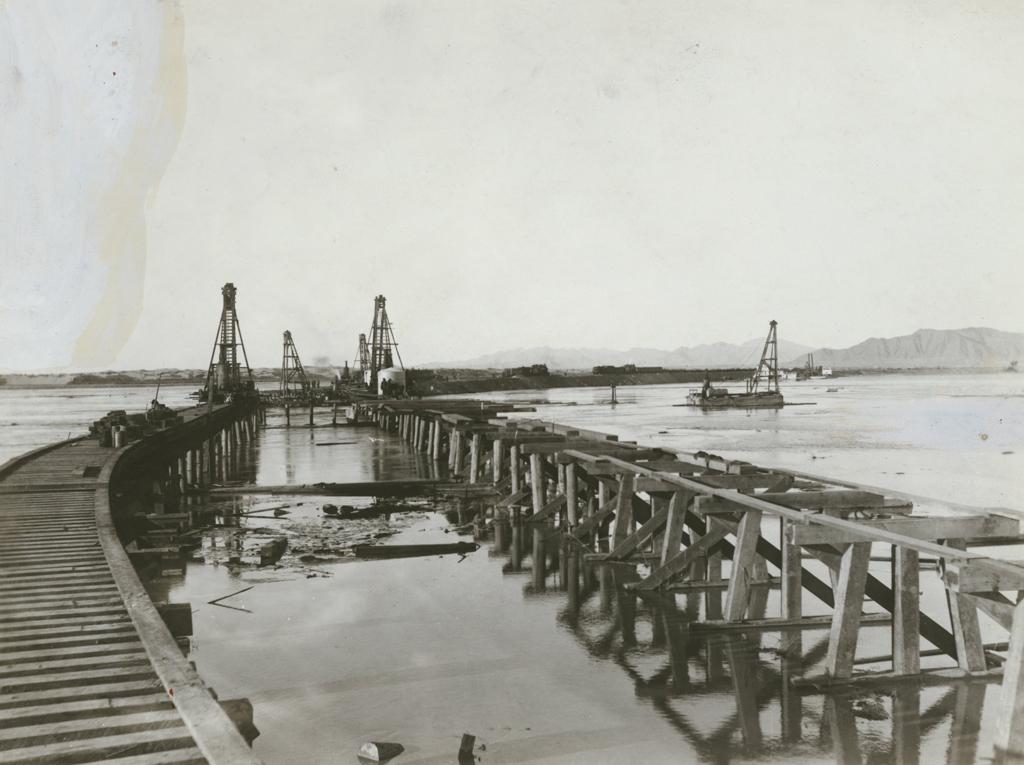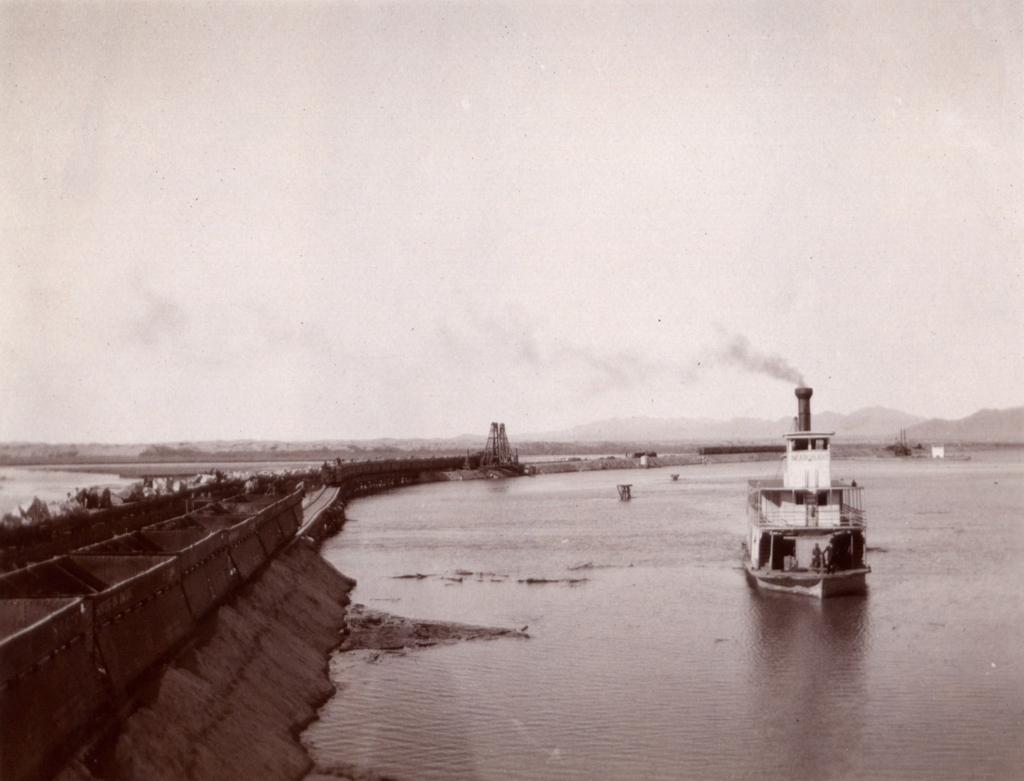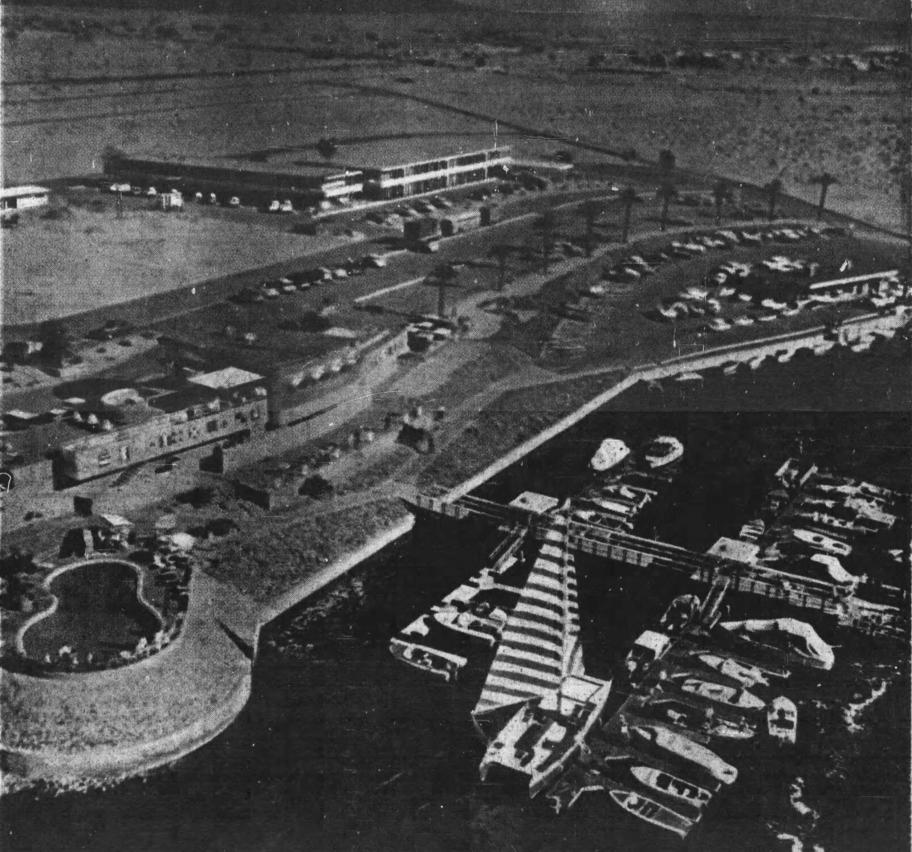The Salton Sea is a large body of salt water in southern California, USA. It lies in an area known as the Salton Trough located between the modern day Imperial Valley and Coachella Valley. The sea was unintentionally formed more than a century ago when flood waters from the Colorado River surged through a series of irrigation canals and natural channels into the Salton Sink. The Salton Sea (centered in image) in southern California near the west coast of the United States. Notice that the Salton Sea is the only human made object visible from space at this distance. An outline of the state of California has been added to the image for reference. High Resolution Image Over millions of years, the tectonic movement in the region, in a process called crustal spreading, caused a section of northwestern Central America, just south of the Salton Sea, to separate from the main land mass and created what is now known as the California Baja Peninsula. As the rift between the peninsula and mainland widened, the area between them subsided, filled with water from the Pacific Ocean, and formed what is now known as the Gulf of California / Sea of Cortez. It is a commonly publicized theory that silt deposits from the Colorado River cut off the northern part of the gulf / sea from the rest of the water and created the predecessor to the Salton Sea, a much larger lake known as Lake Cahuilla. But that is not completely accurate. Animation Depicting Creation of the Salton Sea without consideration of Tectonic Plate Movement Contribution This animation portrays the Colorado River Delta silt deposits cutting off the northern section of the gulf / sea. It fails to demonstrate the contributions of tectonic plate movement to the creation of the sunken land that Lake Cahuilla and the Salton Sea would eventually occupy. It may lead viewers to believe lakes in this region were solely created by silt deposits, which is not correct.
The land that the Salton Sea occupies and the surrounding regions have been known by many names over the years and include many modern day municipalities as well as Native American locations. Below are the names of some of the larger areas;
The Salton Sea
Super High Resolution Image
Origins of the Salton Sea
The Salton Sea would not exist without the unique geology of southern California, USA and northwestern Mexico and water from the Colorado River
Names of the Salton Sea
The Salton Sea as viewed from space, taken on March 11, 1969 from inside the command module of the NASA Apollo 9 spacecraft (Gumdrop)
Tectonic Plate Movement
Most geologists believe the basin where the Salton Sea is now located was never part of the Gulf of California / Sea of Cortez and was actually far above sea level in the distant past. Geological evidence strongly indicates that it was tectonic movement through the ages that caused the region to subside hundreds of feet below sea level and create the basin the Salton Sea now occupies.
Animation of Tectonic Plate Movement
This animation demonstrates the tectonic plate movement that created the California Baja Peninsula, Gulf of California / Sea of Cortez, and the region that would one day become the Salton Sea.
Silt Deposits
As tectonic movement split the California Baja Peninsula from the mainland, the area between subsided and created the Gulf of California / Sea of Cortez. Silt deposits from the Colorado River later flowed into the gulf / sea and created the Colorado River Delta.
While the bed of the gulf / sea subsided, vast amounts of silt deposited by the river caused the surface elevation westward of the mouth of the river to rise faster than it was sinking. Regions to the north of the river mouth that were above sea level subsided over time, sinking below the elevation of the rest of the delta. Eventually the delta of the river would include this unique inland delta that would one day become the Salton Sea.
Rather than sequestering the northern basin of the gulf / sea, as is commonly publicized, the silt deposits that formed the delta served as a barrier to prevent the gulf / sea from intruding into the basin.
Map of the Colorado River Delta – 1933
The black outline represents the entire Colorado River Delta, including the unusual inland delta where the Salton Sea exists.
Sources & Additional InformationFormation of a Lake
The path of the Colorado River has historically wound its way through Arizona, Mexico, and typically into the Gulf of California / Sea of Cortez. But over the millennia, the river’s course has naturally altered many times and flowed into the Cahuilla Basin instead of the Gulf of California / Sea of Cortez, filling the basin and creating a body of water known as Lake Cahuilla.
Although it formed in the same area as the Salton Sea, it was a much larger body of water.
Map of Lake Cahuilla with an outline of the Salton Sea for Comparison
Sources & Additional InformationEvaporation and Rebirth of Lake Cahuilla
After Lake Cahuilla formed and the Cahuilla Basin was completely filled, the lake overflowed, cut channels through the Colorado River Delta, and allowed the excess water to drain into the Gulf of California / Sea of Cortez.
Because of flooding from the Colorado River and the easily manipulated alluvial soil of the delta, the course of the river changed many times over the years, sometimes flowing into the Cahuilla Basin and sometimes flowing directly into the gulf / sea. When the basin was deprived of its main water supply from the river, it would evaporate and disappear as the desert climate and rare rains were not enough to sustain the lake.
The cycle of filling the basin and complete evaporation of the lake would repeat itself many times over the millenia.
Map Showing the Flow of the Colorado River into the Cauilla Basin and then out to the Gulf of California / Sea of Cortez after the Basin Filled.
This view is looking north at southern California, USA with the Pacific Ocean to the upper left.
1761 – A General Map of North America
“A General Map of North America”, by British cartographer John Rocque, contains one of the first modern historical references to a body of water where the current Salton Sea is located. The map, sometimes referred to as the ‘Rocque Map of North America’, indicates the presence of a body of water where the Salton Sea would one day form. It also depicts a river flowing into the lake from mountains to the north. It is inaccurate because the terrain between the lake and the Colorado River to the east makes it physically impossible for water to flow into or out of the region shown on the map. The map correctly depicts the junction of the Colorado River and Gila River.
Most of the Rocque Map is based on other maps and verbal descriptions from explorers rather than first hand observation by Mr. Rocque. There is very little written evidence beyond the map that supports the existence of a body of water in the region that predates the Salton Sea. But later exploration of the area would prove that a lake had existed there in the past.
At the time publication the map was the most accurate and complete representation of the North American Continent which also included a body of water where the Salton Sea would one day exist.
A General Map of North America by John Rocque
Original Full Title; A general map of North America; in which is express’d the several new roads, forts, engagements, &c. taken from actual surveys and observations made in the army employ’d there, from the year 1754, to 1761
Note: When examining the map, notice the existence of a body of water located in southern California, USA that predated the Salton Sea by more than a century.
High Resolution Image
Super High Resolution Image
Super High Resolution Image with Super Zoom
Full Size RAW
1783-1898 – United States of America Expansion
Expansion of the United States continued with the purchase of the Louisiana Territory from France in 1803. Over the next half century, exploration, mapping, and development of newly acquired territories was commissioned by the United States government resulting in hundreds of different expeditions, the most famous made by Lewis and Clark. The last large acquisition in the expansion of the continental United States was from the Mexican government shortly after the conclusion of the Mexican – American war in 1848. The new territory included California among other future states.
The United States intended to expand further south by purchasing land from Mexico that included the California Baja Peninsula in what would be known as the Gadsden Purchase of 1853, but the Mexican president Santa Anna balked at the offer and instead agreed to the purchase of less territory that did not include the peninsula. The territory gained from the purchase was mainly intended to provide an easier route for a southern transcontinental railroad. It included land south of New Mexico and Arizona, but did not include land west of the Colorado River that would one day be used to provide irrigation water to southern California.
During this period, the California Gold Rush reached its peak, prompting population increases and proposals to build transcontinental railroads.
Map Depicting Territorial Expansion of the United States of America between 1783 and 1898
High Resolution Image
Super High Resolution Image
Sources & Additional Information
Nov 1853 – William Phipps Blake
In the fall of 1853 an explorer named William Phipps Blake traveled to an area in southern California, USA known then as the Colorado Desert, which would one day become the home of Salton Sea.
Mr. Blake was tasked by the United States Congress to explore potential routes for a transcontinental railroad along the southern border of the country. After compiling the information collected, he submitted a report of his explorations to congress in 1858. The report included the first modern scientific observations and measurements of the region, including the fact that portions of it were below sea level.
The report contained a wealth of information, including an opinion about reclaiming the desert land and turning it into rich farmland with water from the Colorado River.
William P. Blake and Companions Entering the Colorado Desert on November 15, 1853
Perspective: The image is drawn looking south, southwest into the Coachella Valley and Salton Trough.
Sources & Additional Information1853 – Lake Cahuilla
Lake Cahuilla is a body of fresh water that existed in the same region the Salton Sea occupies today in southern California, USA . The lake was much larger than the Salton Sea and occupied the entire Salton Trough including most of the area known today as the Imperial Valley. Over several millennia the lake formed and disappeared many times due to evaporation and changing path of its main water source, the Colorado River.
An explorer named William Phipps Blake visited the area in the 1850s as part of an expedition to explore possible routes for the Transcontinental Railroad for the United States of America. He was the first person to scientifically assess and describe the region in great detail. At the time of his exploration the lake was dry, but as part of his study of the area Mr. Blake found evidence that a great lake had once existed in what was then a desert. He named it Lake Cahuilla, after the local Native American people that inhabited the region. In his survey, he postulated that waters from the Gulf of California / Sea of Cortez had at some time in the past extended into the area. This assessment was incorrect as waters from the Gulf / Sea have never encroached into the Salton Trough. The mistake was made because tectonic plate movement and large scale subsidence were not yet understood.
Illustration of Lake Cahuilla and the Surrounding Region
Note; In present day, there is a modern man made reservoir to the west of Vista Santa Rosa, CA, USA named Lake Cahuilla. The reservoir occupies a very small section of the northern portion of the basin where the ancient Lake Cahuilla existed.
Sources & Additional Information1857 – 19th Century Irrigation Systems
In 1857 Oliver Meredith Wozencraft made the first widely publicized proposal to take water from the Colorado River and divert it to the area where the Imperial Valley and Salton Sea exist today for irrigation. At the time, the entire region was a dry desert landscape known as the Colorado Desert. It would be almost another half century before the Salton Sea was created and the region to the south became the rich verdant farmland it is today.
Several years prior, William P. Blake conducted a survey of the region and included similar ideas about irrigation in a report submitted to the United States Congress. Mr. Wozencraft’s had a much grander concept in mind than Mr. Blake’s. He wanted to fill the entire Salton Trough with water diverted from the Colorado River, recreating the ancient Lake Cahuilla, and then draw irrigation water from the lake. If his plans had come to fruition, the Imperial Valley would be much smaller than it is today.
Wozencraft continued to promote the idea for many years, but nothing was developed or came of his proposal until well after his death.
Typical Irrigation System used in the 19th Century
Sources & Additional Information1867 – Exploration and Reclamation
After the American Civil War, the focus of the United States of America turned to reconstruction and exploration of the territory in the west for developing natural resources. Among the many development projects considered were the reclamation of desert lands in the western United States of America, including the Salton Trough, where the Salton Sea lies today.
Several small scale reclamation efforts were made to ‘reclaim’ and irrigate the desert lands of the southwest USA. This included the Salton Trough where the Imperial Valley and Salton Sea are located. These endeavors were made before the Newlands Reclamation Act of 1902. Reclamation was possible in the Salton Trough because of readily available water supply from the Colorado River to the south.
The Imperial Valley, CA, USA in 1901 before Water was Introduced for Irrigation
Jan 1873
For many years Joseph Widney had proposed refilling the Salton Sink with water from the Colorado River and recreating the ancient inland lake.
It garnered support from the California Congress and eventually became known as the Widney Sea, but never came to fruition.
Early Map of the ‘Widney Sea’
The map includes locations of future cities as reference points.
Sources & Additional Information1877
The Southern Pacific Railroad completed a railway from Los Angles, through the Salton Sink and Colorado Desert, to Yuma, AZ.
This was the first major step in developing the region that would soon become the Imperial Valley.
Southern Pacific Railroad Train Depot in the Salton Sink
Sources & Additional Information1884
In the late 19th century salt was a much prized commodity, far more valuable than it is today. The New Liverpool Salt Company was the first large industry created in the Salton Sink. Unlike salt mined in other regions, the salt in the Salton Sink was extremely pure, making it a very profitable venture for many years.
The railway, finished by the Southern Pacific Railroad several years prior, was a key part of making this endeavor possible, as well as many other business ventures in the future.
The New Liverpool Salt Company in the Salton Sink
Notice the railroad tracks and boxcar to the right of the building and the piles of salt with men on them between the main building and the boxcar.
High Resolution Image
Super High Resolution Image
Super High Resolution Image with Super Zoom
1889
San Diego County originally included the Salton Sink and the Imperial Valley among other locations.
Official Map of San Diego County California, USA
Drawn by Thomas D. Beasley under the supervision of James Dix Schuyler – 1889
High Resolution Image
Super High Resolution Image
Super High Resolution Image with Super Zoom
Jun 1891
Unusually high water volume of the Colorado River caused it to overflow into the Salton Sink and resurrect a small portion of Cahuillia Lake once again. The lake only grew to a shallow depth and occupied a much smaller area compared to past incarnations.
This was the last natural formation of the lake prior to the creation of the body of water now known as the Salton Sea.
Early Map of the Imperial Valley showing areas prone to flooding. The Alamo River (also known as the East River and Salton River) is not indicated on this map.
Sources & Additional Information
Jan 1892
The Colorado River Irrigation Company was formed to create a series of canals and bring water from the Colorado River into what would become the Imperial Valley with Charles Rockwood as the chief engineer. The company did not escape the financial crisis of 1893 and ultimately failed in 1894.
All of the records, maps, surveys, and data related to the irrigation project were turned over to Mr. Rockwood in compensation for his unpaid salary.
Map of Irrigable Lands with Planned Routes for Canals
Note; This map was only a proposal for the reclamation, development, and irrigation of the ‘Colorado Desert’ with no consideration for a permanent body of water. The area labeled as the Salton Sink is drawn as a body of water because it was known that the region would occasionally flood to a very shallow depth.
High Resolution Image
Super High Resolution Image
Super High Resolution Image with Super Zoom
May 1893
The San Francisco Chronicle reports on the efforts of the Colorado River Irrigation Company and Dr. Rockwood to acquire property in the Colorado Desert and the plan to irrigate it with water from the Colorado River.
Newspaper Clipping from the San Francisco Chronicle May 6, 1893
Sources & Additional InformationApr 1896
The California Development Company was created by Charles R. Rockwood as a successor to the Colorado River Irrigation Company. It had a similar purpose which was to bring irrigation water from the Colorado River and deliver it to the soon to be named Imperial Valley.
Having already worked on the project for several years with the Colorado River Irrigation Company, Mr. Rockwood had tremendous faith that the project would be a profitable success.
Charles Robinson Rockwood, 1860-1922
Sources & Additional Information1896 – 1900
Because of difficulties with the planned route of the main canal, doubts in the ultimate success of irrigating the ‘Colorado Desert’, and the distraction of other national events, such as the sinking of the USS Maine, significant work on the project was not advanced for almost half a decade.
During this time, Charles Rockwood desperately tried to find investors for his company and funding for the project, but was unsuccessful.
USS Maine Sunk in Havana Harbor on Feb 18th, 1898
Sources & Additional InformationMar 1900
George Chaffey joined the California Development Company (CDC) as an investor, president, and chief engineer. He created the Imperial Land Company with several other people to promote settlement of the region, thus providing customers for The CDC and the water they would soon deliver from the Colorado River. As part of the promotional effort, it was decided to change the name of the Colorado Desert and Salton Trough to the Imperial Valley as it was felt that terms like desert and sink might deter people from moving to the region.
Without Mr. Chaffey’s investment, the CDC would never have survived and the canals would never have been built, however he was also solely responsible for planting the seeds of disaster. He only remained with the company a couple of years before divesting his shares, leaving Charles Rockwood in charge of the business.
George Chaffey, 1848 – 1932
Sources & Additional InformationApr 1900
The original plans from the Colorado Irrigation Company had called for the canal to be routed west around the southern edge of the Algodones Dunes. But that path was considered too costly and time consuming by Mr. Chaffey, so the route of the Alamo Canal, later known as the Imperial Canal, was modified.
The beginning of the canal was moved further south near Pilot Knob, CA, USA (red circle). But instead of going west towards the Imperial Valley, its path turned south into Mexico running roughly parallel with the Colorado River for about 4 miles (green line). From there it connected (purple circle) with with naturally existing overflow channels known as the Alamo Arroyos (yellow lines) with one that was dredged and enlarged into a canal sized channel. The path of the dredged canal meandered westward across Mexico where the other arroyos combined to form the Alamo River (blue line) which continued westward until turning north and crossing the border back into California, USA at Sharp’s Heading (orange circle) and then into the Imperial Valley.
The changes from the original planned route, among many other modifications made by Mr. Chaffey, would later prove to be significant contributing factors to the flooding of the Salton Sink.
Planned Route for the Imperial – Alamo Canal
May 1900
Because the vast majority of the Imperial / Alamo canal’s planned route was in Mexico, permission had to be obtained from the Mexican government along with the purchase of vast amounts of property in Mexico. The government eventually granted permission on the condition that the ownership and operations of the canals in Mexican territory be controlled by a Mexican company. The Colorado Development Company agreed and formed La Sociedad de Riego y Terrenos de la Baja California, Sociedad Anonima (The Irrigation and Land Group of Baja California, Anonymous Group).
Modern examination of these business transactions has discovered some were of a questionable nature and it is suggested that the Mexican Government and citizens were taken advantage of by the US companies.
Mexican Flag Overlay of Mexico
Sources & Additional InformationTimeout: Question, Answer, and an Explanation
"Why was the Imperial / Alamo Canal (green line) dug 4 mile in the opposite direction of where the water needed to be delivered, parallel to the Colorado River?
Answer: Geography, Money, Politics, and the Law
Geography; The southwestern portion of California, USA includes a small mountain range referred to as the Chocolate Mountains. This range comes to an end in southern California, USA close to the US / Mexican border at Pilot Knob, California, USA, just north of Hanlon Heading close to where the Chaffey Headgate was built and the Hanlon Headgate still exists today. In the south and west, the mountain range tapers off into a region known as the Algodones Dunes which extends into Mexico for several miles. The land to the south of the dunes slopes downward from east to west and on the west side the downward grade continues north into the Imperial Valley and Salton Sea. The easiest way to deliver water from the Colorado River to the Imperial Valley is around the southern edge of the Algodones Dunes in Mexico.
Money; To dig a canal within the boundaries of the United States where the All American Canal exists today (thin dark green line labeled All American Canal) would have cost millions of dollar even in 1900 and the California Development Company had neither the resources nor time to construct a canal on that scale. The predecessor to the California Development Company (The Colorado River Irrigation Company) had planned the route of the canal (blue line) to skirt around the southern edge of the dunes in Mexico and then north into the United States. The canal engineer, George Chaffey, went one step further and decided to route the canal (light blue line) through the existing Alamo Arroyos as an additional cost savings measure. The route was longer, but it was much cheaper and faster to dredge out the arroyos into larger channels than to dig a new canal that followed the edge of the dunes.
Politics; From an engineering standpoint placing the start of the canal about 4 miles to the south of the US / Mexican border would have made much better sense than the actual beginning of the canal at Pilot Knob. The canal was constructed in this manner to overcome a technical legal issue as to the ownership of the water. Because the water from the Colorado River entered the canal in US territory, it meant that the water delivered to the Imperial Valley was 'American' water', not 'Mexican water'.
Satellite Image of Algodones Dunes and Imperial Valley in Southern California, USA
High Resolution Image
Super High Resolution Image
Super High Resolution Image with Super Zoom
Aug 1900
Construction of the Chaffey Headgate for the canal’s water intake from the Colorado River was started just inside the US / Mexican border, south of Pilot Knob, USA. Originally, the headgate was to be located several miles upstream at Potholes, CA, USA, but George Chaffey elected to relocate it as a time and cost savings measure. The wooden structure was supposed to be temporary with a permanent concrete headgate constructed further upstream where the Hanlon Headgate was eventually built, but there were no firm plans or a timeline to complete the task.
Mr. Chaffey also constructed the bottom of the headgate too high which prevented proper water flow into the canal during the summers when the river level was lower.
Chaffey Headgate at Pilot Knob, USA
This picture was taken looking north at the rear of the headgate shortly after its completion in 1901
Dec 1900
A dredge named Alpha was used to dig the main channel of the Imperial – Alamo Canal starting from just inside the US side of the Mexican border at Pilot Knob, CA, USA. After crossing the US / Mexico border, it dug south about 4 miles where it connected to the Alamo Arroyo. George Chaffey, the engineer of the canal, failed to consider the high silt level of the Colorado River and did not design or construct the channel in a fashion that would prevent build up of silt.
The problems arising from the deficiencies of the canal were not noticed for several years and would later prove to be the original source of a future disaster.
Dredge Alpha
Notice the dim silhouette of the Algodones Dunes to the north on the left of the picture.
Sources & Additional InformationMay 1901
Water from the canal system first flowed into the Imperial Valley on May 14th, 1901 when the headgate at Sharp’s Heading was opened. Shortly after that the irrigation of farmland began in earnest, but not all of the water delivered to the valley was used.
Excess water was allowed to flow into the Salton Sink marking the birth of the new Salton Sea.
Early Relief Map of the Lower Colorado River Region and Imperial Valley
Notice the area that appears to be the Salton Sea is actually the Salton Sink as this drawing was made half a decade before the floods that created the Salton Sea. The white lines north of the border leading to the Salton Sea are the New River and Alamo River.
Sources & Additional Information1902 – 1903
The Newlands Reclamation Act of 1902 was passed by the US congress, but did little to immediately affect the Imperial Valley as reclamation of the desert land to irrigable farmland was already well under way.
The population of the Imperial Valley quickly grew to over 50,000 people in just a couple of years and irrigable land increased to well over 100,000 acres. Entire towns were built, railroads were extended, and hundreds of miles of additional canals were built to deliver water to individual farms.
With the water flowing and readily available, growth in the region exploded, but there were problems on the horizon.
Imperial City, early 1900s
Sources & Additional Information1904
The Salton Sea was created by flood waters from the Colorado River that traveled through a largely uncontrolled canal system. Flooding of the river was a normal summer occurrence prior to the construction of the Boulder / Hoover Dam and other dams upstream of of the Imperial / Alamo Canal. During these floods, the water level of the river could rise as much as 20 ft., increasing the water flow by more than 20 times the average volume.
The difficulties and perils of of designing a canal system that could handle such wildly ranging extremes were not fully understood by the canals original designer, George Chaffey. It would prove to be problematic and dangerous in the future.
The Glen Canyon Dam During Construction 1963
Note; Although the Glen Canyon Dam is upstream of the Imperial / Alamo Canal, Boulder / Hoover Dam is the primary dam for flood control of the southern Colorado River.
High Resolution Image
Super High Resolution Image
Super High Resolution Image with Super Zoom
Jan 1904
The Colorado River carries a great deal of silt as it flows downstream. From the very beginning of its existence, this presented a problem for the Imperial – Alamo Canal. As the silt built up on the bed of the upper 4 mile section of the canal over the years, it caused the water flow to steadily decline.
The crops growing in the Imperial Valley were desperately thirsty for more water, but the canal system simply couldn’t deliver enough. The first effort to correct the problems was an attempt to remove the silt and increase the water supply by scouring the channel, but it failed. Dredging was considered, but neither time or money was available to complete such a large task.
If the California Development Company couldn’t find a solution for delivering adequate water, crops would die and the Imperial Valley would cease to exist.
Clam-Shell Dredge
Sources & Additional InformationSept 1904
In addition to silt build up in the upper 4 mile section of the Imperial / Alamo Canal, deficiencies were discovered with the Chaffey Headgate that prevented sufficient water flow to the expanding cropland in the Imperial Valley when the Colorado River level was low . Several additional channels were dug at the north end of the canal to bypass the headgate that allowed more water into the valley, but because they were built without headgates the water flow could not be controlled.
Decisions like this would prove to be a costly mistake in the future.
Map Depicting Bypass Channels around the Chaffey Headgate
Notes; In this illustration, the Chaffey Headgate is indicated by an X. The bypass channel in US territory was dug around the headgate. A line in this channel seems to indicate the existence another headgate, but nothing was ever constructed at that location. Heading No. 1 was also referred to as Intake # 1 and the Upper Mexican Heading was also referred to as Intake # 2.
Sources & Additional InformationOct 1904
The largest of the new channels dug was the Lower Mexican Heading , located about 4 miles south of the US / Mexican border. It was dug to bypass the upper 4 mile section of the Imperial / Alamo Canal north of the heading that had been rendered unusable from silt deposits. After completion, a sufficient water supply for the the Imperial Valley was restored, but as with the other bypass channels, it too lacked a headgate to control the flow of water.
There were plans to install a headgate, but building one at this location required the consent of the Mexican government and unfortunately it was not approved until the following year.
Map Depicting Location of The Lower Mexican Heading
Note; The Lower Mexican Heading was also referred to as Intake # 3.
Sources & Additional InformationJan 1905
The water that gave birth to the Salton Sea can be traced back to surface runoff from an unusual number of severe storms in the areas surrounding the upper Gila River, upper Colorado River, and their tributaries during the winter and early spring. Downstream, the unusual rainfall caused several massive floods that swept through the lower Colorado River region.
The volume of water that flowed through the lower Colorado River in the first half of 1905 was the largest amount ever documented since record keeping began.
Depiction of Heavy Runoff from Storms into a River Valley
High Resolution Image
Super High Resolution Image
Super High Resolution Image with Super Zoom
Feb 1905
Several unexpected winter floods on the lower Colorado River caused heavy silt build up in the Lower Mexican Heading and severely reduced the amount of water that could be delivered to the Imperial Valley for farms and crops. After the channel was dredged the canal system was once again able to provide a sufficient water supply for the valley.
Maintaining adequate water flow was the primary objective of the engineers, who had very little concern over potential flooding in valley. This would prove to be a very serious mistake.
Inside the Lower Mexican Heading , West of the Colorado River
Duplicate pictures from two different sources are presented here in order to provide alternate views from the limited quantity of low quality images available. They were taken from within the Lower Mexican Heading looking east. The steep banks on either side of the channel are the dirt and silt that was dug up to create the heading.
Mar 1905
Another unexpected flood, the third of the year, washed down the Colorado River and through the Lower Mexican Heading . But unlike the floods from the previous month, this one scoured the channel making it wider and deeper. This startled Mr. Rockwood to such a degree that he immediately made the decision to close the heading before the larger summer floods arrived.
Construction was started on a dam that was designed in a similar fashion to others that had successfully closed the Upper Mexican Heading in earlier years. It was almost complete when the fourth flood of the year swept the structure away.
All seemed lost to Mr. Rockwood and his engineers and it was feared they might loose control of the river.
Construction of the Dyke at the Lower Mexican Heading Looking South
Note; This picture was actually taken June 1, 1905 and shows the third attempt to close the Lower Mexican Heading . It was used here because photographs from the first and second effort to close the heading cannot be found, but since the photo demonstrates the same methods, efforts, tools, and instruments used to construct the dam described above, it was placed here.
High Resolution Image
Super High Resolution Image
Super High Resolution Image with Super Zoom
Super High Resolution Image with Extended Panoramic View and Super Zoom
Note; The Extended Panoramic View includes the southern end of what would be known as ‘Disaster Island’ and the eastern shore of the Colorado River with trees partially submerged by the enlarged river.
Sources & Additional InformationApr 1905
After the destruction of the first dam, work immediately commenced on a second dam in a frantic attempt to close the Lower Mexican Heading and prevent the flood waters from destroying the Imperial Valley. A new location was chosen, closer to the mouth of the heading where it was determined the bed of the canal was firmer, making it less likely that the dam could be undermined by swift currents.
Closing the heading would reduce the amount of water delivered to the farms in the valley, but there were no fears about providing adequate water to the valley as the Colorado River was running so high that even the silt choked Imperial / Alamo Canal was able to supply more than enough water for all the agricultural needs of the valley. All of the excess runoff was allowed to flow into the Salton Sink, giving birth to the modern day Salton Sea.
Halfway through the month, an unprecedented fifth flood of the year careened down the lower Colorado River and destroyed the dam when it was only partially complete, allowing the flow of water into the valley to continue unabated at an ever increasing rate. Dejected and with his business, the California Development Company, almost bankrupt, Mr. Rockwood left for New York, NY, USA in a desperate attempt to secure funding and support from the Southern Pacific Railroad.
Note; This picture was actually taken June 1, 1905. It was used here because the photo demonstrates the same location, methods, efforts, tools, and instruments used to construct the dam described above and because because photographs from this effort to close the heading could not be located.
High Resolution Image
Super High Resolution Image
Super High Resolution Image with Super Zoom
May 1905
At the behest of Charles Rockwood and the California Development Company (CDC), Edward Henry Harriman, president of the Southern Pacific Railroad (SPR), considered investing $200,000 in the CDC. Mr. Harriman was intrigued by the prospects of growth in the Imperial Valley and what it would mean for the Southern Pacific Railroad’s business interests in the valley. Also faced with the destruction of a large portion of the SPR infrastructure in the valley, he concluded that $200,000 was a relatively small investment to make. As part of the deal Mr. Harriman obtained majority control of the CDC for the Southern Pacific Railroad, something he would regret in the future.
If not for this investment, the California Development Company would have soon collapsed and the flood waters would likely have continued to fill the entire Salton Sink and Imperial Valley, drowning all of the farms, houses, cities, and everything else in the region under hundreds of feet of water.
Edward Henry Harriman, 1848 – 1909
Note; This picture of Mr. Harriman was taken in 1906
Sources & Additional InformationJun 1905
During Mr. Rockwood’s absence the previous month, a third effort to stem the unchecked flow of water through the Lower Mexican Heading commenced. Upon his return from New York, NY, USA Mr. Rockwood found the dam inundated by water on all sides from the summer floods. He determined that construction efforts were useless in the face of the rising flood water and terminated the endeavor until after the floods had passed.
At the end of the month the spring and summer floods had widened the heading from the original 55 foot (17 meters) width to over 100 feet (30 meters) and almost triple its original depth. The ongoing torrent of water flowing through the heading and into the Imperial Valley caused the Salton Sink to fill at an alarming rate.
Map of the Lower Mexican Heading June, 23, 1905
This map depicts the location of the second and third attempts to dam the Lower Mexican Heading at its mouth on the west bank of the Colorado River.
Sources & Additional InformationAug 1905
After the flood of the previous month that ended the most recent effort to tame the rampaging Colorado River, the Lower Mexican Heading had increased in width by several hundred feet to over 300 feet. Combined with the larger width, the increased depth of the channel from the original 8 foot depth to over 20 feet, allowed more than two thirds of the river to flow into the Imperial Valley.
In the valley, farmers were happy that water was no longer in short supply as it had been in previous years, but the Southern Pacific Railroad infrastructure and the facilities of the New Liverpool Salt Company faced a growing threat from the rising waters of the Salton Sea.
With the financial support from the Southern Pacific Railroad, the California Development Company was hopeful and started making elaborate plans to control the river and maintain the water supply for the farms in the valley.
View Looking South, Down the Colorado River from Disaster Island
Note; The water to the left of the photo is the eastern channel of the Colorado River as it flows around Disaster Island.
High Resolution Image
Super High Resolution Image
Super High Resolution Image with Super Zoom
Sept 1905
After 4 failed attempts to bring an end to the flooding of the Salton Sink and Imperial Valley, a much larger, concerted effort was planned at a new location and thanks to the funding from the Southern Pacific Railroad it could be turned into reality.
Two main issues confronted the California Development Company and their engineers. The most obvious was a dam to curtail the untamed flow of water into the valley, but equally as important was maintaining the water supply for all of the farms. Unlike in the spring and summer, the water of the Colorado River is normally much lower in the fall, making it impossible for the silt clogged Imperial / Alamo canal to carry enough water for the thirsty crops growing in the valley.
Simply damming the river was not enough. A way to maintain an ample water supply to the valley had to be found as well, otherwise the crops would wither and die.
Map of the First Five Attempts to Close the Lower Mexican Heading
This map shows the location of the various efforts to dam the Lower Mexican Heading .
Sources & Additional InformationOct 1905
A fifth attempt was made to curtail the uncontrolled waters flowing into the Imperial Valley from the Colorado River by building a dam. The dam, known as the Edinger Dam, was similar to the previous effort to build a jetty from the small sandy island, now known as Disaster Island, in the middle of the river channel to the west bank. After the dam was completed, it was successful in forcing a large amount of the river into the channel to the east of the island while still allowing sufficient water into the canal system to provide irrigation to the farms in the Imperial Valley.
Hopes were high that the structure would keep the river at bay, but tragically the water had different plans.
Edinger Dam During Construction
This picture was taken on Oct 21, 1905 from ‘Disaster Island’, downstream and behind the dam, looking north up the Colorado River. The dam was based on pilings driven into the riverbed with large mats, referred to as mattresses, attached to the pilings. Once the mattresses were put in place, dirt, silt, and rocks were piled up on the upstream side of the dam to complete it.
High Resolution Image
Super High Resolution Image
Super High Resolution Image with Super Zoom
Special ‘Before & After’ Comparison Super High Resolution Image
Nov 1905
With the threat to the Imperial Valley averted everyone was relieved, but late in the month a flood swept down the Colorado River and completely destroyed the Edinger Dam , washing it away downstream.
After the flood and the destruction of the dam, engineers were horrified to find the entire river was rushing through the Lower Mexican Heading into the Imperial Valley, leaving a dry bed where the river had once flowed to the Gulf of California / Sea of Cortez.
Remnants of the Edinger Dam After it was Destroyed
This picture was taken slightly behind the dam on Disaster Island looking northwest towards the upper Colorado River and its west bank on Dec 13, 1905 after the Dam was destroyed on Nov 30, 1905.
High Resolution Image
Super High Resolution Image
Super High Resolution Image with Super Zoom
Special ‘Before & After’ Comparison Super High Resolution Image
Dec 1905
As part of the plan to preserve water delivery to the Imperial Valley for farming after the Lower Mexican Heading was closed, construction was started on a new concrete headgate located just north of the wooden Chaffey Headgate at Pilot Knob, CA, USA. The anticipated completion date for the soon to be named Hanlon Headgate was early spring but, unfortunately it wasn’t finished until well into the summer.
To the south, water from the Colorado River continued to pour into the Imperial Valley through the Lower Mexican Heading and this critical delay in construction compounded the problem of diverting the river and stopping the flooding of the valley.
Construction of Concrete Headgate at Hanlon Heading near Pilot Knob
This picture was taken looking north towards Pilot Knob, USA. Notice that just a bit of the Colorado River is visible on the far right of the image.
High Resolution Image
Super High Resolution Image
Super High Resolution Image with Super Zoom
Jan 1906
Work on another headgate in Mexican territory, slightly north of the Lower Mexican Heading, commenced at the beginning of the month as the first part of a larger plan to control the Colorado River and prevent the flooding of the Imperial Valley.
The Rockwood Headgate , named after the head engineer of the project, Charles Rockwood, was constructed out of wood as it was viewed that this structure would only be used as part of the effort to close the Lower Mexican Heading (LMH) and then temporarily as the main inlet for the canal until the new concrete headgate at Hanlon Heading and dredging of the upper 4 mile section of the Imperial / Alamo Canal was complete.
Work for the headgate had originally been scheduled to begin in August of 1905, but was delayed until the beginning of the year to allow the limited resources available to focus on the Edinger Dam instead. This delay would not come without consequences.
The Rockwood Headgate Under Construction just North of the Lower Mexican Heading (LMH)
Note(s); The location of the headgate was situated directly in the channel of the Imperial / Alamo canal, presumably for ease of access to the construction area for the pile drivers that were mounted on barges. The notations on the photograph were made by the photographer. The Dredge Alpha is above the named labeled “DIPPET DREDGE”.
High Resolution Image
Super High Resolution Image
Feb 1906
The purpose of the Rockwood Headgate and the new channel it was located in was to provide an alternative controlled path for the Colorado River to flow into the Imperial / Alamo Canal and onto the farms in the Imperial Valley. After the river was turned into the new channel the Lower Mexican Heading would be left dry, removing the added difficulty of building a structure in moving water, and allow a levee to be constructed across the heading, sealing it off permanently.
It was imperative the headgate be finished as quickly as possible to stop the flooding of the Salton Sink and Imperial Valley, so construction continued day and night.
Rockwood Headgate Under Construction
Note(s); This photograph was taken looking northeast with the Gila Mountains in the background at the right the image. Although the water isn’t visible, the boat labeled ‘Suction Dredge’ is actually floating in the Imperial / Alamo Canal behind the construction zone. The smoke stacks at the right of the image are for the electrical generators that were used to provide power for lighting so work on the headgate could continue during the night.
High Resolution Image
Super High Resolution Image
Mar 1906
The next step in the plan to close the Lower Mexican Heading and stop the flood waters that continued to threaten the crops growing in the Imperial Valley included a new dam, known as the Hind Dam , to the south of the Rockwood Headgate that would be built across the heading. To aid in the dams construction, a railroad trestle was built which would allow massive amounts of material to be delivered by train.
With the approaching spring and summer floods that could easily destroy the railroad trestle, construction was halted at the northern shore of the Lower Mexican Heading until the floods had passed.
Construction Begins on Railroad Trestle to Aid in Building Hind Dam
Note; The southern edge of the Algodones Dunes can be seen in the background in between the two pile driver towers. The dunes were the geographical barrier in southern California, USA that forced the Imperial Alamo Canal to be routed through Mexico. The two large ‘ladder towers’ are the pile drivers that drive piles into the ground, similar in function to a hammer driving a nail in to a piece of wood.
High Resolution Image
Super High Resolution Image
Modern Steam Pile Driver in Action
Other Similar Pile Drivers of the Era and a Miniature Replica in Action
Apr 1906
Although certainly destructive, the disaster unfolding in Mexico at the Lower Mexican Heading and the floods in the Imperial Valley paled in comparison to the massive earthquake that struck San Francisco, California, USA on April 18, 1906.
Even though no ground shocks from this devastating earthquake were felt in the Imperial Valley, its effects certainly were. Equipment like the grab / ‘clam shell’ Dredge Delta and other supplies stockpiled in San Francisco that were to be delivered to the heading and the Imperial / Alamo Canal were stranded in the city by the devastation.
The resources of the Southern Pacific Railroad were taxed to their limits in northern California, USA and with costs continuing to rise for the construction projects related to the canal, there were serious doubts that Mr. Harriman and the Southern Pacific Railroad would or even could continue to fund the efforts to stop the raging Colorado River.
Panoramic View of San Francisco after the 1906 Earthquake
Note(s); The photograph was taken by a specialized camera, mounted to a massive assembly of kites, looking south over San Francisco and centered on Market Street. The Southern Pacific Railroad Infrastructure, including the depot, rail yard, and warehouses located on two wharves built into the bay are at the far left of the image.
High Resolution Image
Super High Resolution Image
Super High Resolution Image with Super Zoom
Super High Resolution Image Identifying Streets and Southern Pacific Infrastructure in San Francisco, CA, USA
May 1906
While work progressed at the Lower Mexican Heading (LMH) to dam the heading and prevent the water from the Colorado River from flooding the Imperial Valley, 4 miles to the north in California, USA efforts to build a new heading and headgate proceeded.
The purpose of the new Hanlon Heading was to make it possible to continue delivering water to the thirsty crops in the valley after the LMH was closed.
The delayed start for the Rockwood Headgate combined with the Hanlon Heading construction being behind schedule meant that efforts to close the LMH could not continue until after the spring and summer floods had passed. Meanwhile the Salton Sea continued to grow in size as the entire Colorado River continued to pour through the valley and into the sea.
Panoramic View of Construction at Hanlon Heading
Note; This panoramic image was constructed from three different pictures taken from the top of Pilot knob looking southwest at the Colorado River. It includes almost all of the infrastructure at Hanlon Heading built until this point. Please use the interactive map to see all of the different components of this panorama.
High Resolution Image
Super High Resolution Image
Super High Resolution Image with Super Zoom
Interactive Image
Jun 1906
The Hanlon Heading was completed after six months of construction, but would not be put into operation for several months because four miles to the south, the Lower Mexican Heading (LMH) had yet to be sealed.
The LMH continued to carry the entire Colorado River into the Imperial / Alamo Canal system and onto the Imperial Valley raising the surface of the Salton Sea half a foot each day. The waters of the sea were quickly approaching the railroad tracks of the Southern Pacific Railroad and the populace of the valley grew increasingly apprehensive, but nothing could be done to stop the river until after the summer floods had passed.
Hanlon Headgate Completed on June 28, 1906
Note; Similar to an iceberg, after being put into service, the majority of the gate was below water with only about 20 ft. of its 86 ft. height generally visible.
High Resolution Image
Super High Resolution Image
Jul 1906
The Imperial Valley has several naturally occurring water channels, the two largest being the New River and the Alamo River both of which meander north through the valley from the US / Mexican border to the Salton Sea . Before irrigation and reclamation of the valley lands for cultivation, these rivers remained mostly dry and only carried water during extreme flooding of the Lower Colorado River. After large scale farming began, any excess water that wasn’t needed by the hundreds of farms growing crops, was routed into the two river beds.
During the flood, both of these rivers carried water from the Colorado River into the Salton Sea . The vast majority of the flood water flowed through the New River in the west of the Imperial Valley and was completely uncontrolled. A headgate at Sharp’s Heading in Mexico held the flood waters at bay and prevented the destruction of the two main canals that delivered water to the farms in the valley.
If the headgate had failed, many parts of the valley would have been starved of their life giving water.
Headgate at Sharp’s Heading in Mexico
Note; During the flood, the headgate was almost lost by erosion that was undercutting the gates foundation. An extension ramp was built that stopped the erosion and prevented the headgate from failing.
High Resolution Image
Super High Resolution Image
Aug 1906
The Imperial Valley faced a myriad of other threats beyond flooding, including a dangerous cutting back of the New River bed as the flood waters ripped through the soft soil in the valley. The cutback gouged the riverbed to a depth of 50 feet in some places, which was an elevation that was much lower than the surrounding farmland and if allowed to progress to the Imperial / Alamo Canal at Sharp’s Heading, the majority of the valley would be unable to receive water through the gravity fed canal system.
The enormous volume of water flowing through the New River also threatened to gouge a new channel through the middle of the valley to the Alamo River in the east, effectively cutting off half of the crops from their water supply.
Desperate times required measures, so what better way to fix a problem than to blow it up? Dynamite was used to steer the the cutback of the river in a direction that prevented a new waterway from forming between the two rivers.
Extraordinary Erosion of the New River Channel
Note; For size perspective, notice the person standing on the edge of the cliff to the right of the picture.
High Resolution Image
Super High Resolution Image
Super High Resolution Image with Super Zoom
Sept 1906
At the beginning of fall, after the summer flooding of the lower Colorado River had subsided, the Lower Mexican Heading (LMH) had expanded from the original fifty foot width to over half a mile which had allowed as much as 100,000 cubic feet / second of water to pour into the canal system raising the depth of the Salton Sea to over 70 feet.
Thomas J. Hind, the superintendent of construction and the man whom the dam is named for, began building the Hind Dam by first extending two jetties from the north and south shores of the heading to narrow its width. A railroad trestle bridge was then erected across the remaining gap so large railroad cars, nicknamed Battleships, could quickly deliver large rocks from quarries as far as 400 miles away to dump into the water. There was concern that these large rocks would simply sink into the soft silt bed of the heading, so brush mattresses were woven together and then sunk into the water to provide a foundation for the rocks.
The Imperial Valley would likely not survive another flood season, so all hopes of survival depended on the Hind Dam successfully stopping the rampaging waters of the Colorado River.
Construction of the Hind Dam
Note; This image, looking southwest from the upstream side of the dam, shows every major aspect of the construction methods used to build the Hind Dam . The jetty extending into the Lower Mexican Heading from the south shore of the heading is at the top left of the image and the railroad trestle built across the middle of the heading as the focus of the picture showing Battleships unloading their cargo with the weaving of brush mattresses at the lower right of the photo.
High Resolution Image
Super High Resolution Image
Oct 1906
Hopes were high at the beginning of the month after the Hind Dam had successfully closed the Lower Mexican Heading , but there were worrying signs the Rockwood Headgate would not be able to handle the amount of water passing through it. Unexpected swirling eddies in the swiftly moving water at the front of the headgate and backwash at the rear eroded the soil around it and caused the apron at the north end of the it to a slide-out.
A train trestle bridge was hastily erected in front of the headgate in an effort to dump large amounts of rock in the channel to protect it, but as the first load of rock rolled across the bridge it collapsed, causing a train wreck and sending several Battleships tumbling off the tracks. Unable to repair the headgate it eventually split in half and failed, sending a large section spinning off downstream in the swiftly moving current.
Mr. Rockwood later emphatically stated that the he had included large rocks as part of his design to reinforced the aprons for the north and south end of the headgate, but they were never put into place. Based on the series of events that occurred before the failure of the headgate, it is likely that ignoring this design feature was a contributing factor to its destruction.
Train Wreck After Trestle Failure
Note; There are several other images of the Rockwood Headgate and surrounding region available for viewing by hovering or clicking on the ‘double green / brown’ underlined links. They are Rockwood Headgate, Backwash, Slide-Out, Train Trestle Bridge was Hastily Erected, Train Wreck, Battleships, Split in Half, and Spinning Off Downstream.
High Resolution Image
Super High Resolution Image
Nov 1906
After the failure of the Rockwood Headgate , flood waters again surged through the Imerial / Alamo Canal and onto the Imperial Valley and Salton Sea .
Based on the success of the method in building the main section of the Hind Dam across the Lower Mexican Heading (LMH) , a similar process was proposed to arrest the swiftly moving waters by extending the dam northward across the channel in front of the remnants of the headgate.
Everyone familiar with the situation feared that the Southern Pacific Railroad (SPRR) was on the verge of terminating the support it had so generously granted in the efforts to save the Imperial Valley from destruction. Without the backing of the SPRR the valley would be condemned to drown in a watery grave, but thankfully they continued their efforts and the channel was closed.
Rockwood Headgate Site during Construction of Hind Dam Extension to Close Channel in Front of Failed Headgate
Note(s); Almost every major element of the Lower Mexican Heading (LMH) next to the Rockwood Headgate is visible. The northern extension of the Hind Dam is to the left of the image. Notice the remnants of the southern section of the headgate next to the dam extension and the remnants of the north section at the lower right of the photograph.
High Resolution Image
Super High Resolution Image
Super High Resolution Interactive Image
Dec 1906
With the completion of the Hind Dam extension the Colorado River was returned to its usual course, saving the Imperial Valley from certain destruction. But another unexpected flood ripped apart a levee to the south of the dam and though the Hind Dam itself held fast, the collapse of the levee once again allowed the entire contents of the river to careen through the Imperial / Alamo Canal and into the Imperial Valley and Salton Sea.
The outlook was gloomy, but the nightmare grew worse when the Southern Pacific Railroad refused to continue shouldering the entire burden to stop the flood and demanded the business interests and the municipalities of the Imperial Valley contribute as well. The surface of the Salton Sea continued to rise as several weeks passed before the communities and organizations of the Imperial Valley pledged almost one million dollars towards the effort to stop the flooding and save the valley.
Steamer Searchlight Stranded after Levee Breach
Note; The diversion of the water was so swift after the levee breach, the crew of the steamer Searchlight was caught off guard and the boat was left stranded several miles downstream from the Lower Mexican Heading .
High Resolution Image
Super High Resolution Image
Jan 1907
The Salton Sea continued to grow larger, menacing livelihoods and property, while the cutback of the New River moved steadily closer the the Colorado River, and if reached would effectively end the existence of the Imperial Valley .
At the direction of E. H. Harriman, president of the Southern Pacific Railroad (SPRR), the struggle to save the Imperial Valley and halt the flood waters from the Colorado River continued with a greatly expanded scope.
To all of those involved, it had become obvious that simply damming the latest unwanted incursion of the river into Imperial / Alamo canal would be pointless without extending levees downstream for several miles if there was to be any hope of preventing similar disasters in the future. This was far beyond any obligation of the SPRR, so the people of the Imperial Valley turned to the federal government and asked President Roosevelt to step in.
In an amazing insight to the future of the Salton Sea , speculation began about utilizing the sea for recreation and sport.
Train Trestles Built for Construction of Clarke Dam
Note; This picture includes several pieces of equipment used in the construction of the dam, including sledge and barge mounted pile drivers, trains, and other boats. Pilot Knob and the Chocolate Mountains can be seen to the north in the background.
High Resolution Image
Super High Resolution Image
Super High Resolution Image with Super Zoom
Super High Resolution Interactive Image
Feb 1907
After almost two years of flooding the Salton Sea and Imperial Valley the enduring Colorado River was finally tamed with the completion of the Clarke Dam. Much work still remained, including extending the levees to the south, dredging the upper 4 mile section of the canal, and repairing all of the damaged infrastructure in the valley.
The Salton Sea had ceased to rise and as the sea receded it was relegated to the history books as many people predicted the sea would eventually just evaporate and disappear like its predecessors had done countless times before.
Questions also remained about the durability of the levees and dams as to whether they could survive the treacherous spring and summer floods the Colorado River could be depended upon to deliver.
Clarke Dam Nearing Completion
Note(s); This picture was taken just slightly north of the position of the previous months photograph. Careful examination shows the extension of the north and south sections of the Clarke Dam with the channel in between still open.
High Resolution Image
Super High Resolution Image
Next; Recent History
Recent History
Sources & Additional InformationFeb 1908
An injunction imposed by court during New Liverpool Salt Co. trial orders that no more water be allowed to flow into the Salton Sea which necessitates that the Holt Power Company cease operation as it derived its power from water wasted into the Alamo River through its turbines.
Sources & Additional InformationSept 1908
Predictions of the Salton Seas demise were rampant. Evaporation, very little rainfall, paltry amount of runoff from canal system all meant that loss of water was greater than water added.
Sources & Additional InformationJan 1912
The Salton Sea retreats with the surface falling 22 feet since its peak in 1907
Sources & Additional InformationJune 1914
A levee breech causes flooding once again, but it is brief.
Sources & Additional InformationJuly 1915
The level of the Salton Sea continues to drop from its peak depth of 76 feet to just over 40 feet (appx. 10 meters).
Sources & Additional Information1924
PWR (Public Water Reserve) Executive Order 90 (1924) and 114 (1928) by Calvin Coolidge to reserve the boundaries of the Salton Sea, below 244 and then 220 feet (below sea level) for disposal of waste water from irrigation is what set the foundation for the sustenance of the Salton Sea. These orders were revoked by Public Land Order 6105, March 5, 1982.
Sources & Additional Information1924
Long a thorn in the side of Imperial Valley farmers were the complications related to the Imperial / Alamo canal being largely in Mexico. Surveys were done to establish the viability of a canal system to supply the valley completely on US soil.
Sources & Additional Information1925
Salton Sea reaches is lowest level, but…
Sources & Additional InformationMay 1927
Heavy rain and runoff from the past several years, in combination with additional runoff from expanding number of farms has raised the level of the Salton Sea several feet.
Expansion of farmland and additional runoff from irrigated areas approached the level needed to not just sustain the Salton Sea, but raise it.
Sources & Additional Information1927
The Salton Sea’s level rose for several years until the Southern Pacific Railroad complained that land that it owned next to the sea was agreed to not be covered.
Sources & Additional InformationDec 1928
The US Congress passes the Boulder Canyon Project Act and is signed into law by President Calvin Coolidge, paving the way for construction of the All American Canal.
Sources & Additional Information1931
Efforts to improve sections of the Salton Sea shore are made with mention of winter resorts.
Sources & Additional InformationApr 1952
Worries about the Salton Sea center on its rising (rather than falling) level because of the new All American Canal bringing more water to more farms, with the resulting additional runoff and seepage.
Sources & Additional Information1961
Depth of Salton Sea is approximately 52 feet maximum depth
Sources & Additional InformationApr 1962 – North Shore Beach
North Shore Beach was one of several planned developments created near the Salton Sea in the late 1950s. It was envisioned as a recreational resort community on the northeast shore of the Salton Sea.
The developers invested large amounts of money in infrastructure such as roads, power, fresh water supply, and even an airstrip that supported amphibious planes. Potential buyers and investors were tantalized by the prospect of cheap property they felt was destined to increase in value very quickly. A yacht club, boat marina, and hotel were also constructed as part of the project to further entice people to the region.
The North Shore Beach development, featuring a yacht club, marina, and hotel.
Note; The aerial image was taken mid-afternoon looking east from a plane taking off from the landing strip north east of the yacht club and marina.
Sept 1976
Hurricane Kathleen raises the Salton Sea, along with a couple of other hurricanes in the 1970s.
Sources & Additional Information1995
Depth of the Salton Sea is just over 52 feet.
Sources & Additional Information1998
Wild life refuge area at Salton Sea established in 1930 was renamed in honor of Sonny Bono
Sources & Additional Information

